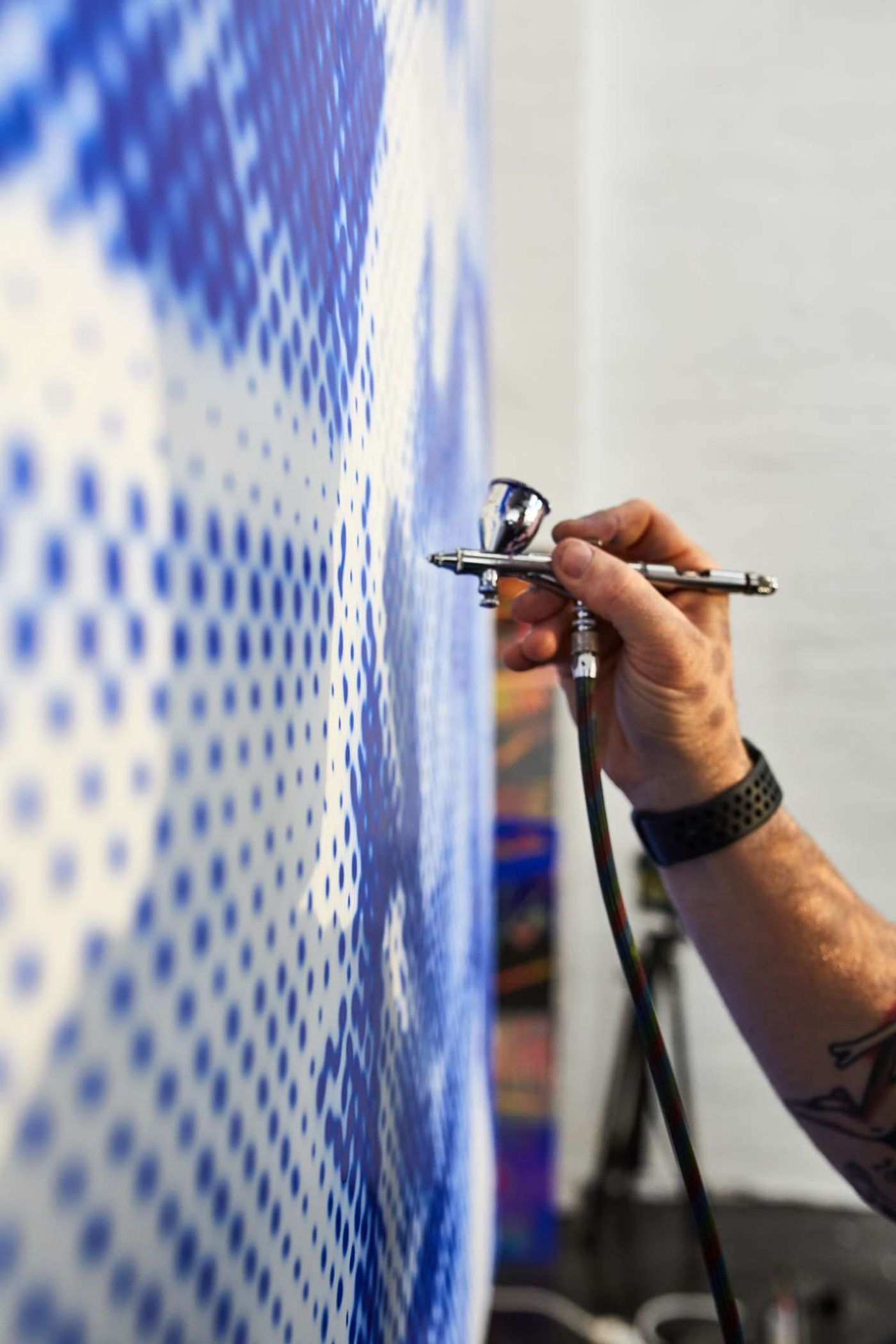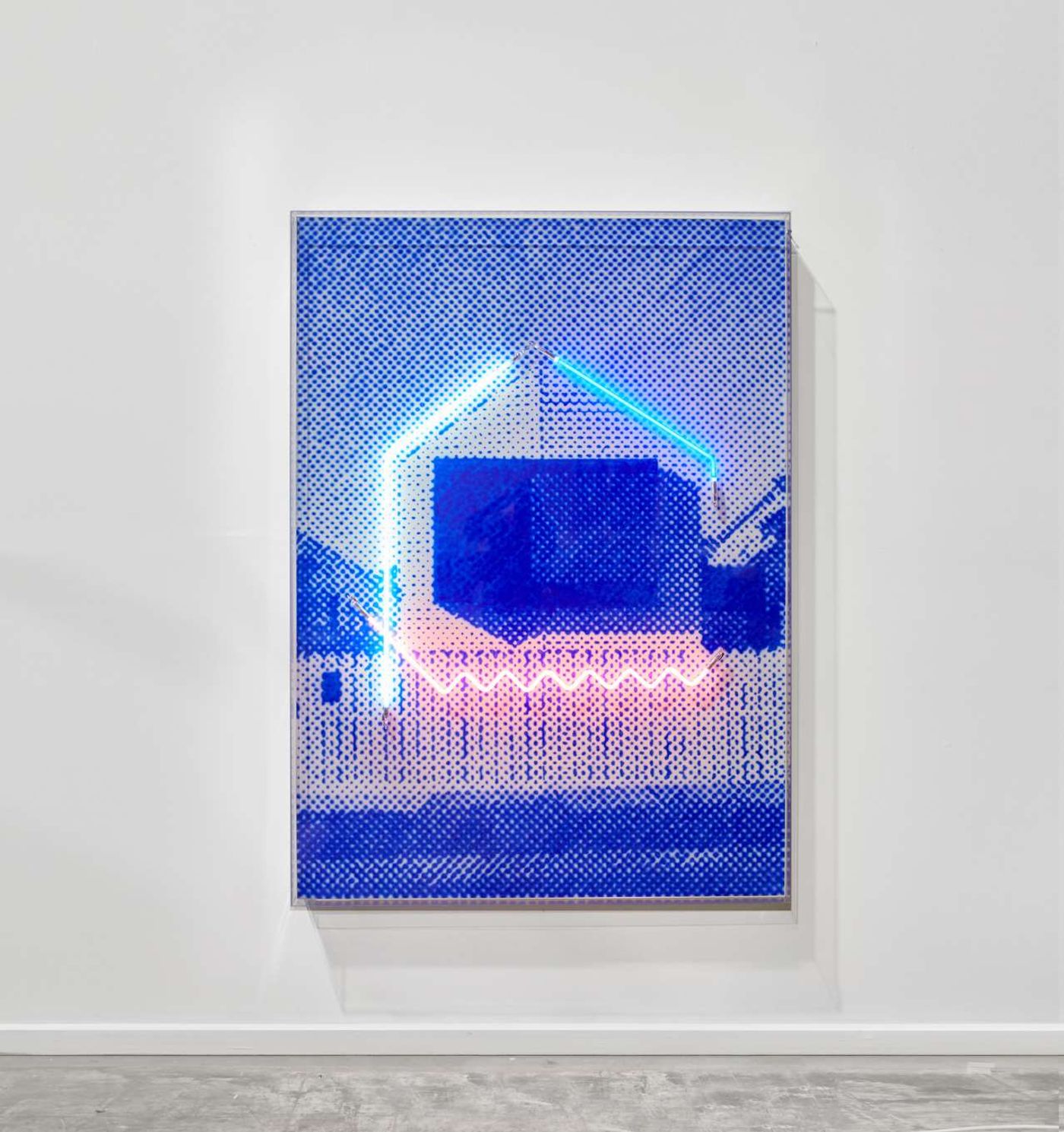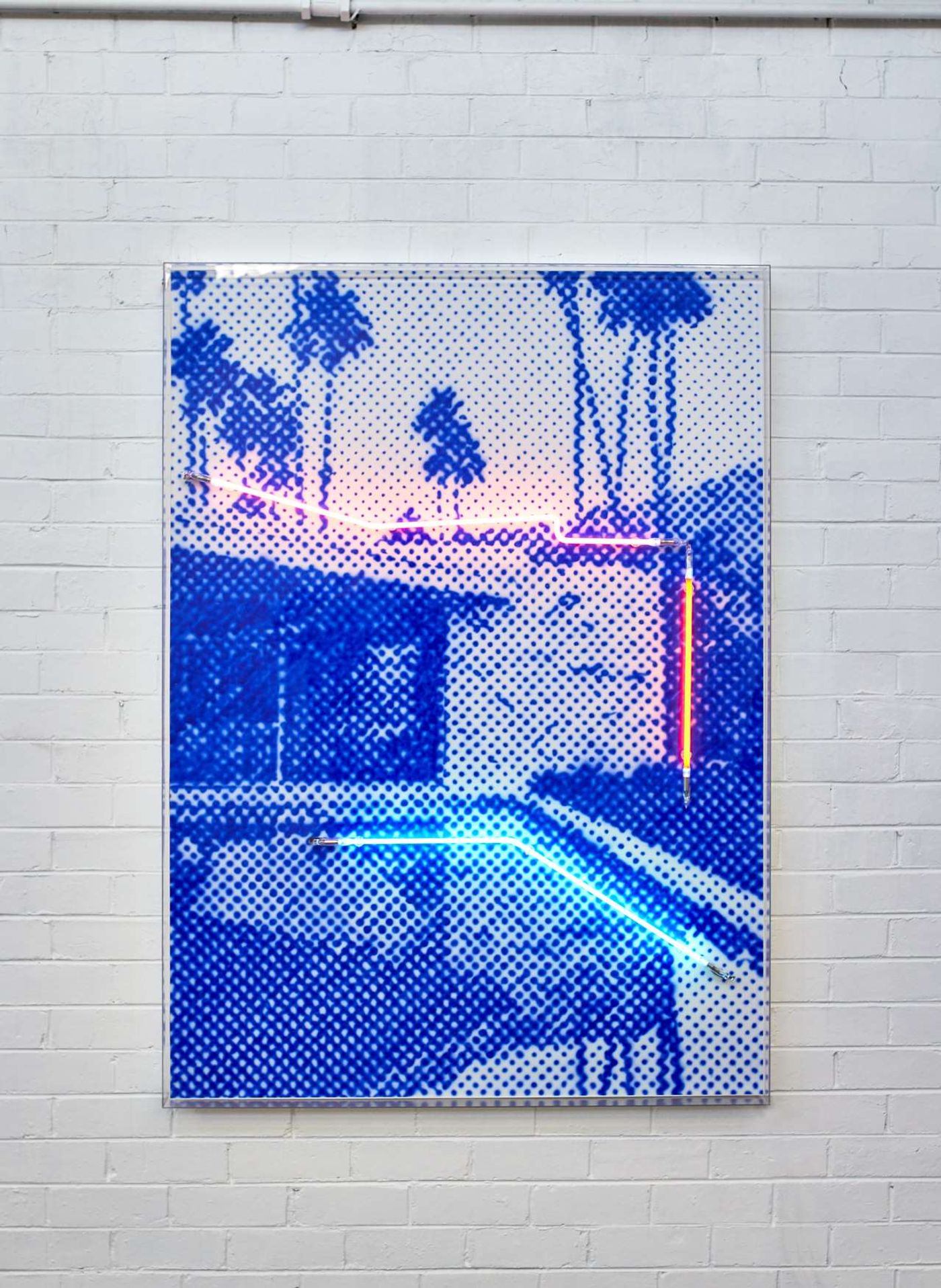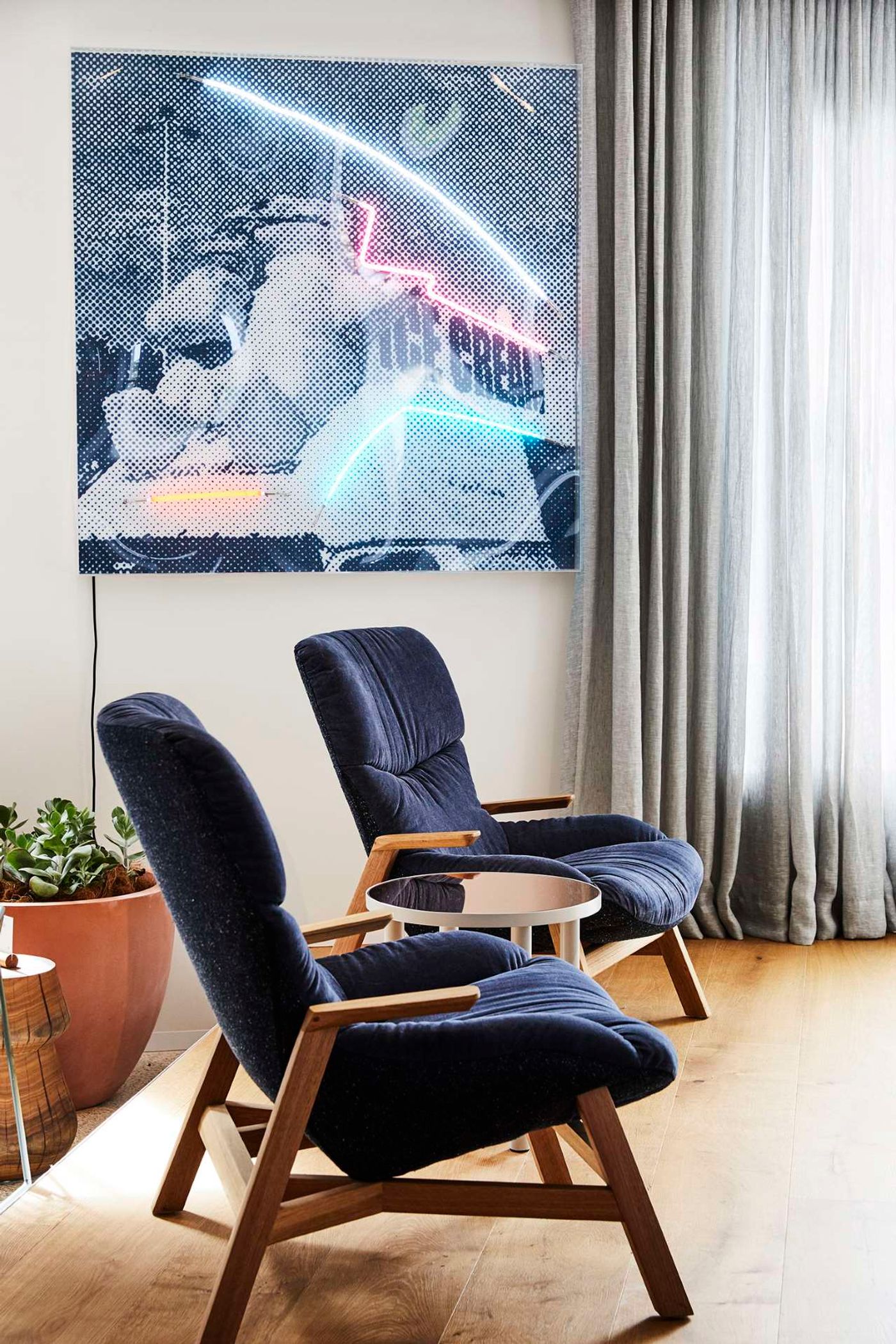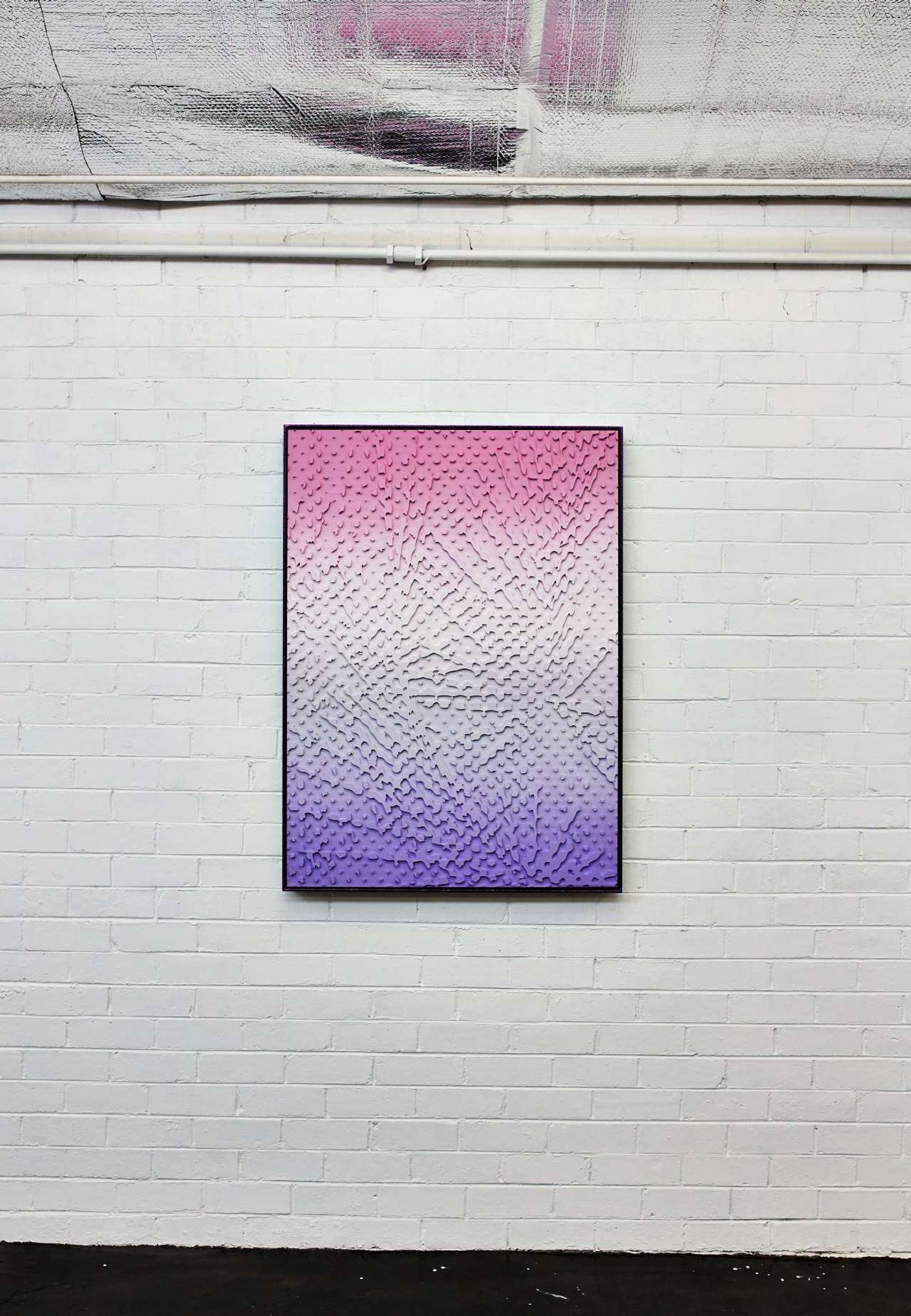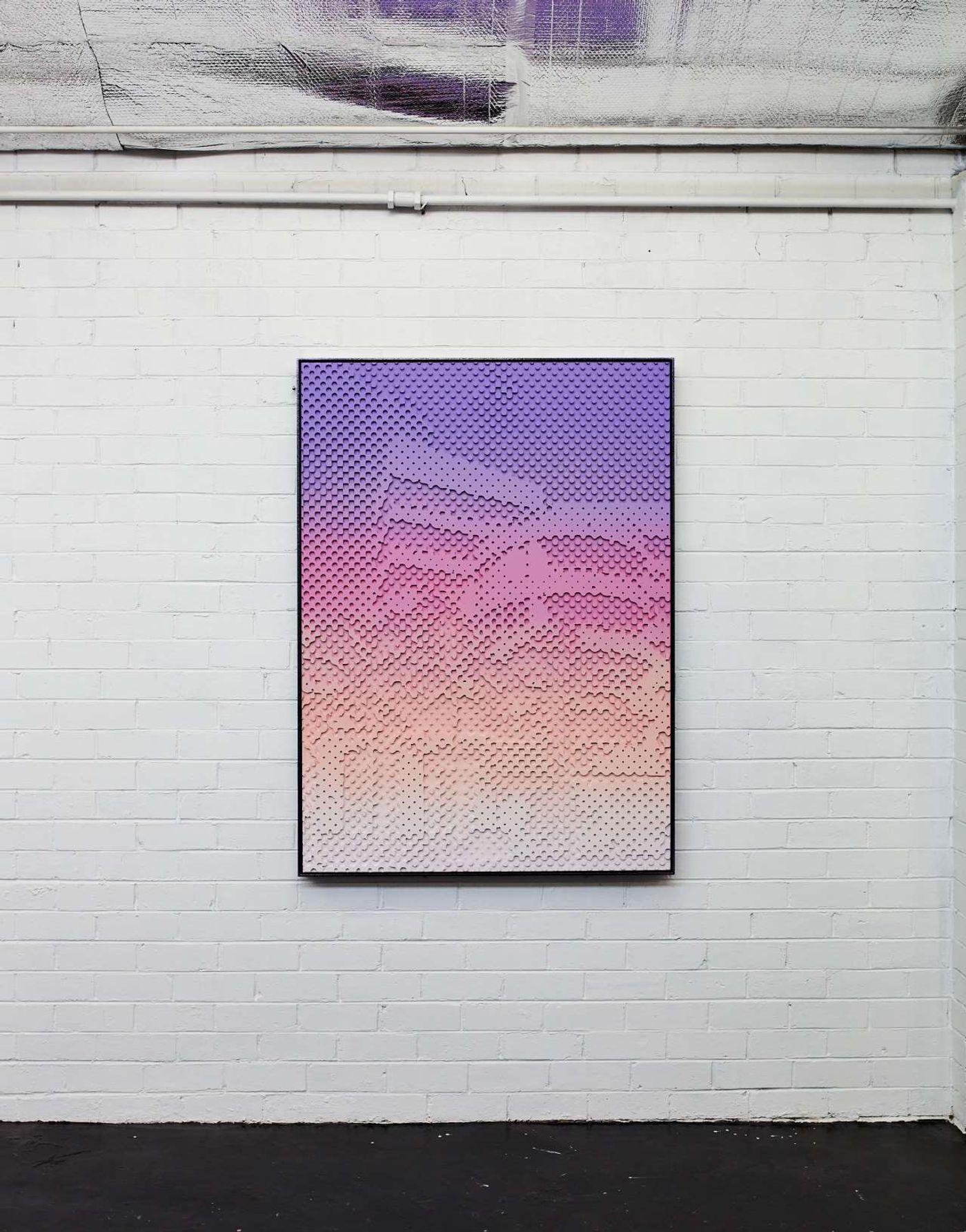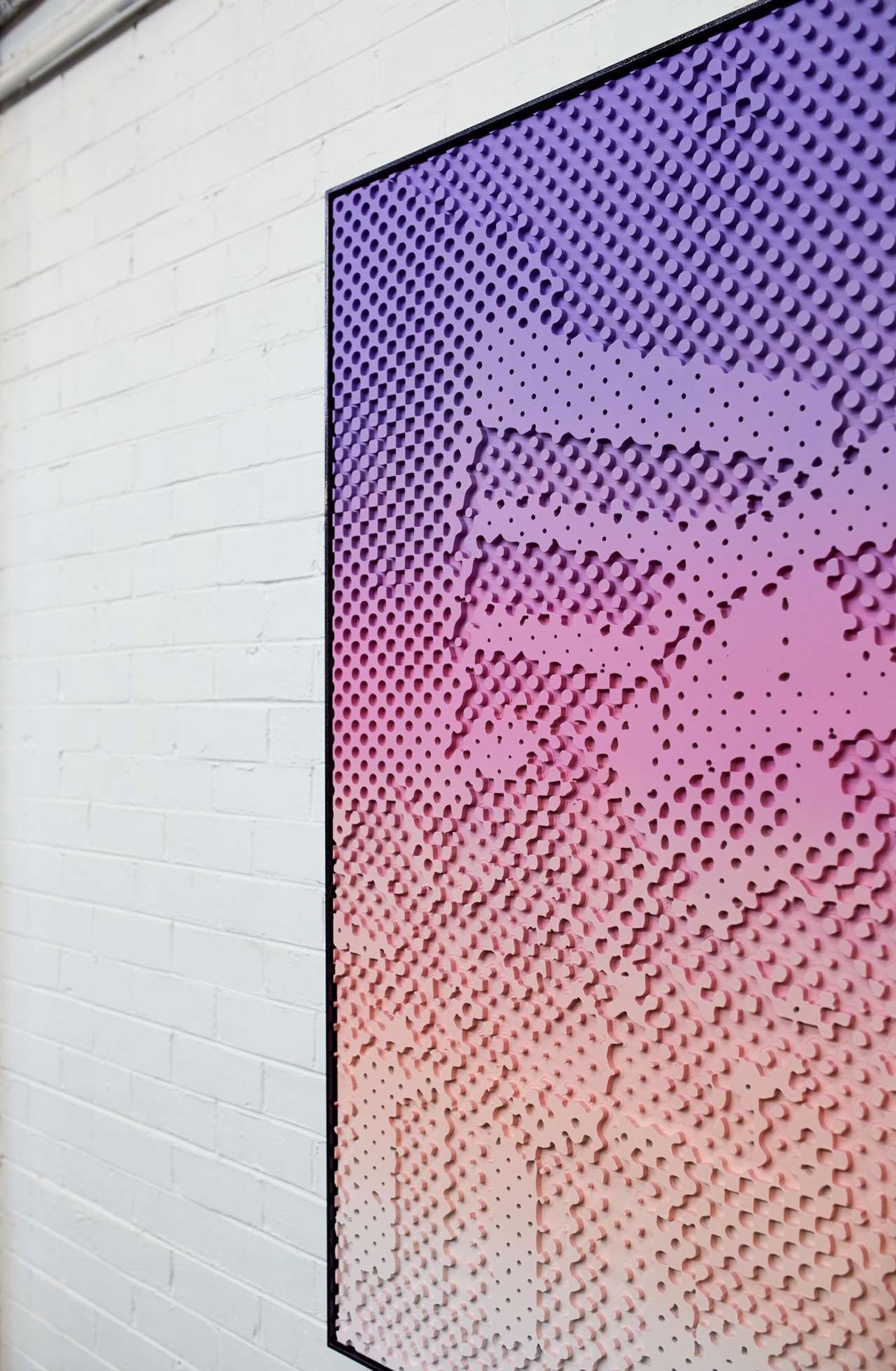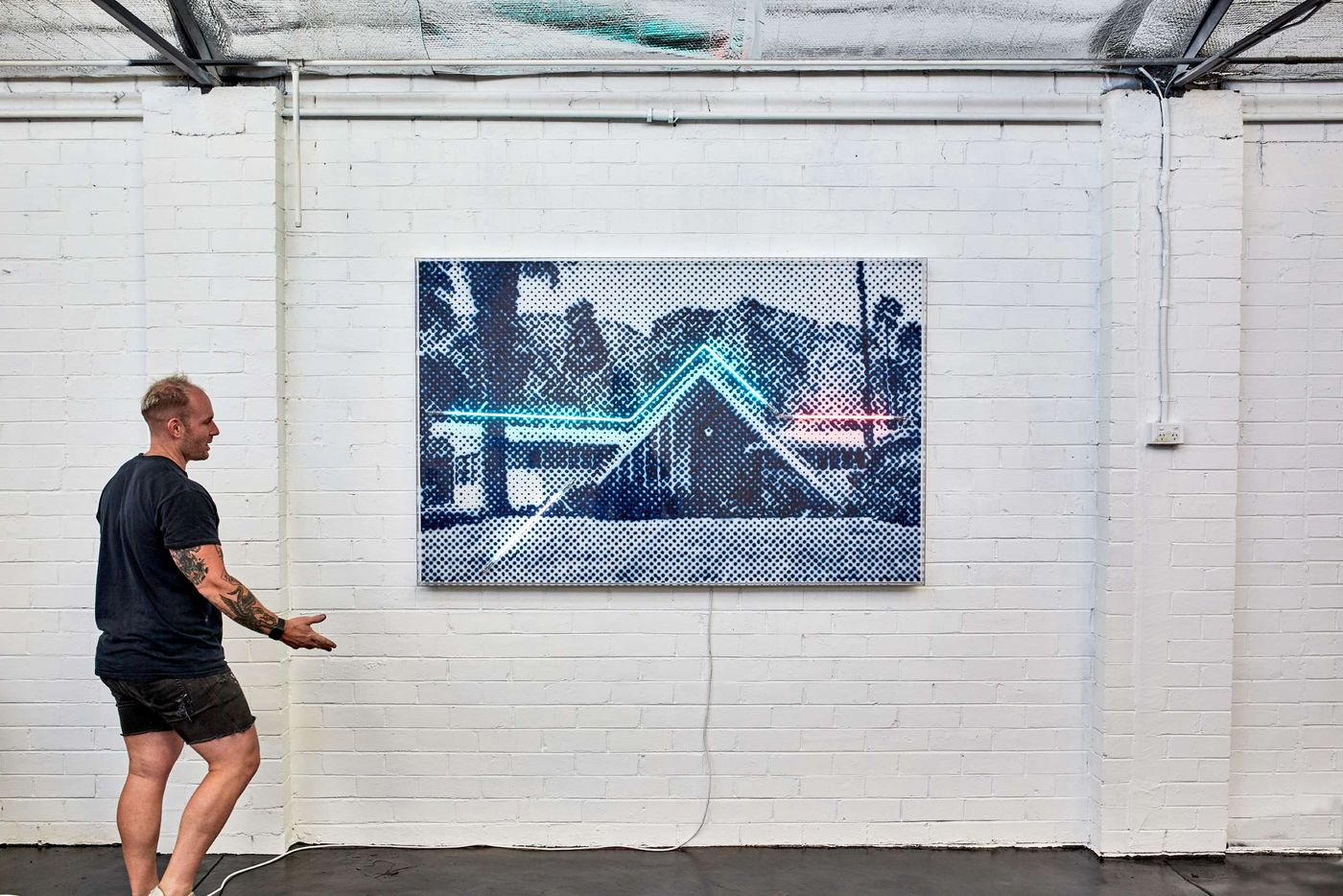
The Deceptive Perfection of Tom Adair's Immaculately Airbrushed Artworks
Words by Eric David
Location
The Deceptive Perfection of Tom Adair's Immaculately Airbrushed Artworks
Words by Eric David
Australian artist Tom Adair works at the intersection of photography, graffiti, and neon creating deceptively unassertive yet elaborate works of elusive detail and hidden depth. Working in his studio in Melbourne he has developed a unique process that digitally translates the photographs that he has shot, often of suburban houses, into monochrome halftone renderings which he painstakingly recreates by hand using an airbrush and later accentuates by overlaying neon lighting tubes. Seen from a distance, Adair’s paintings are poetic renderings of a suburban utopia, but on closer inspection, the paint drips, overspray, and other imperfections undermine the idyllic first impression hinting at an underlying malaise. With a background in street art, Adair has since been developing his oeuvre through an ever expanding range of techniques, mediums and materials, that lately also includes polyurethane foam which he sculpts using a CNC router into three-dimensional halftone images. Yatzer recently caught up with Adair to talk about his studio work, his laborious airbrushing process, and his passion for architecture.
(Answers have been condensed and edited for clarity.)
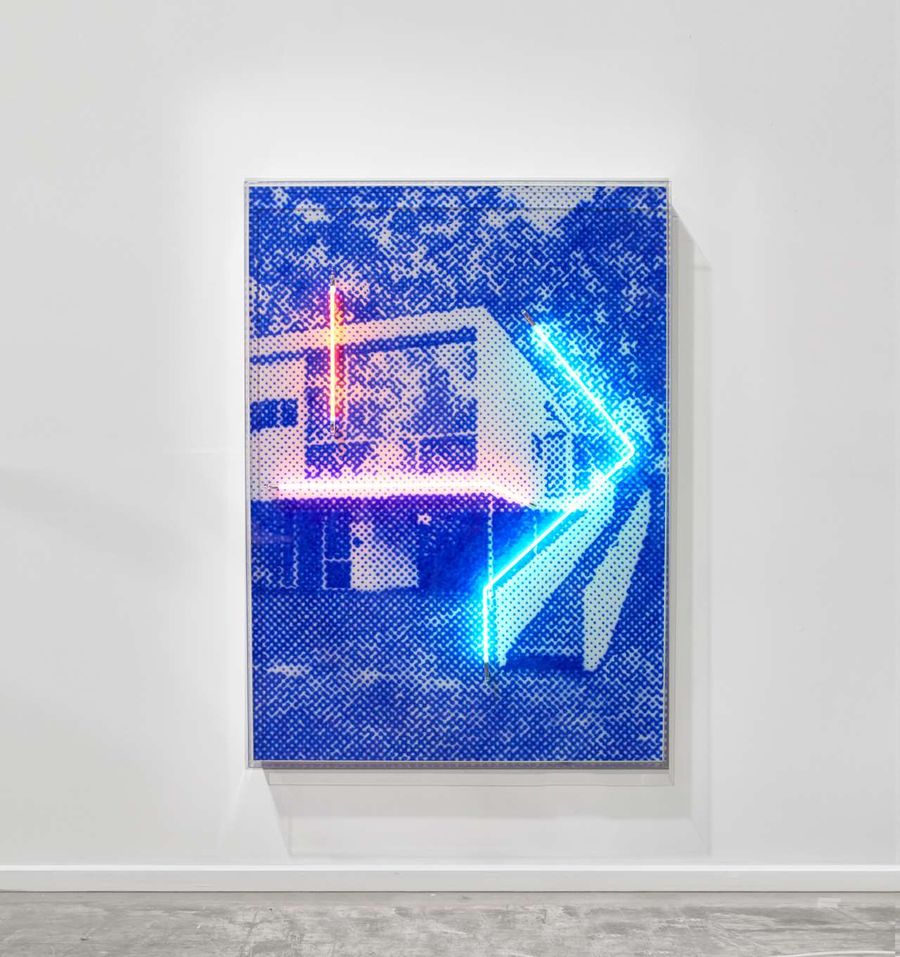
Tom Adair, Bushland beauty, Airbrush acrylic polymer and neon on dibond, acrylic frame, 115x160cm. © Tom Adair.
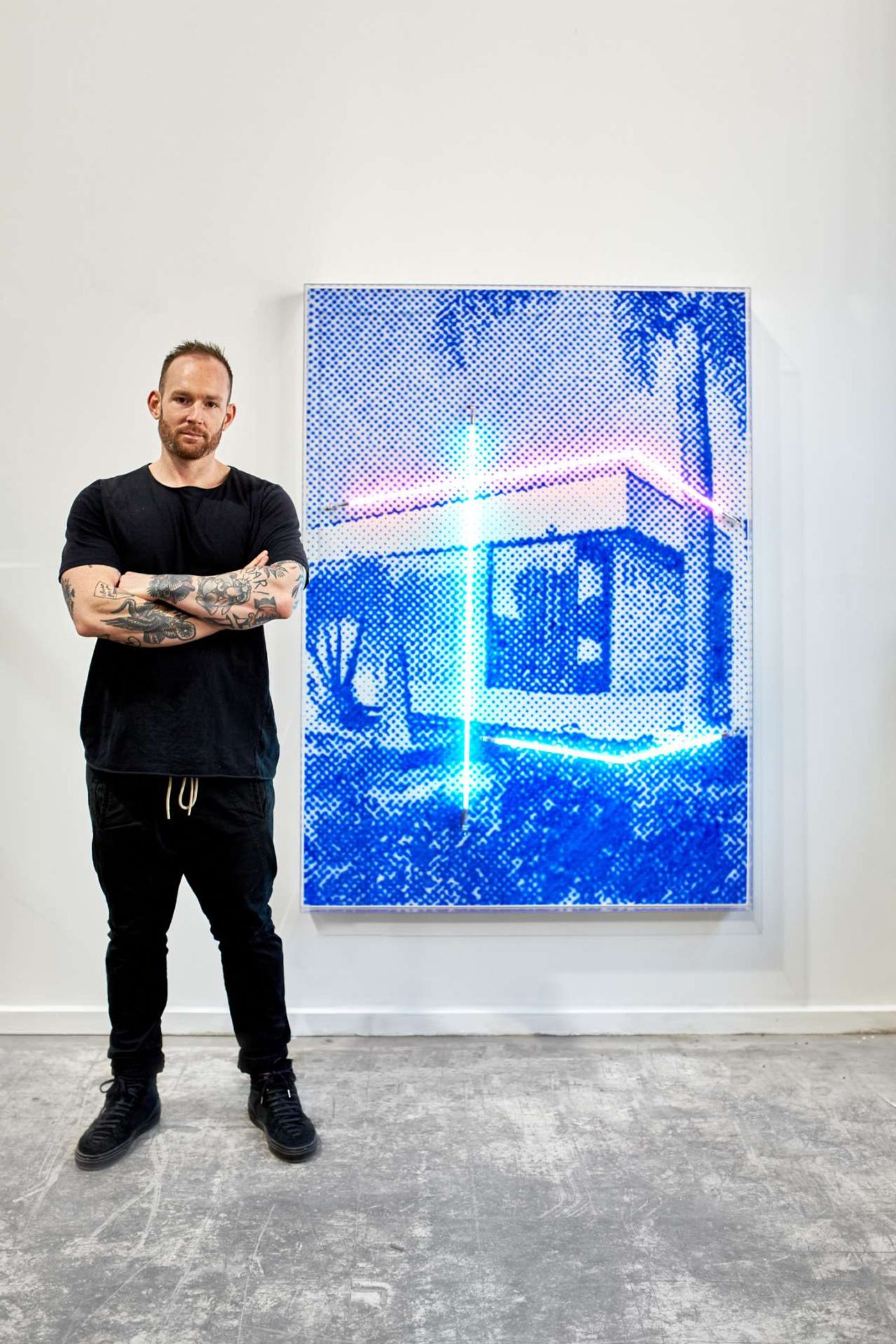
Tom Adair, North facing with palms in the front, Airbrush acrylic polymer and neon on dibond, acrylic frame, 115x160cm. © Tom Adair.
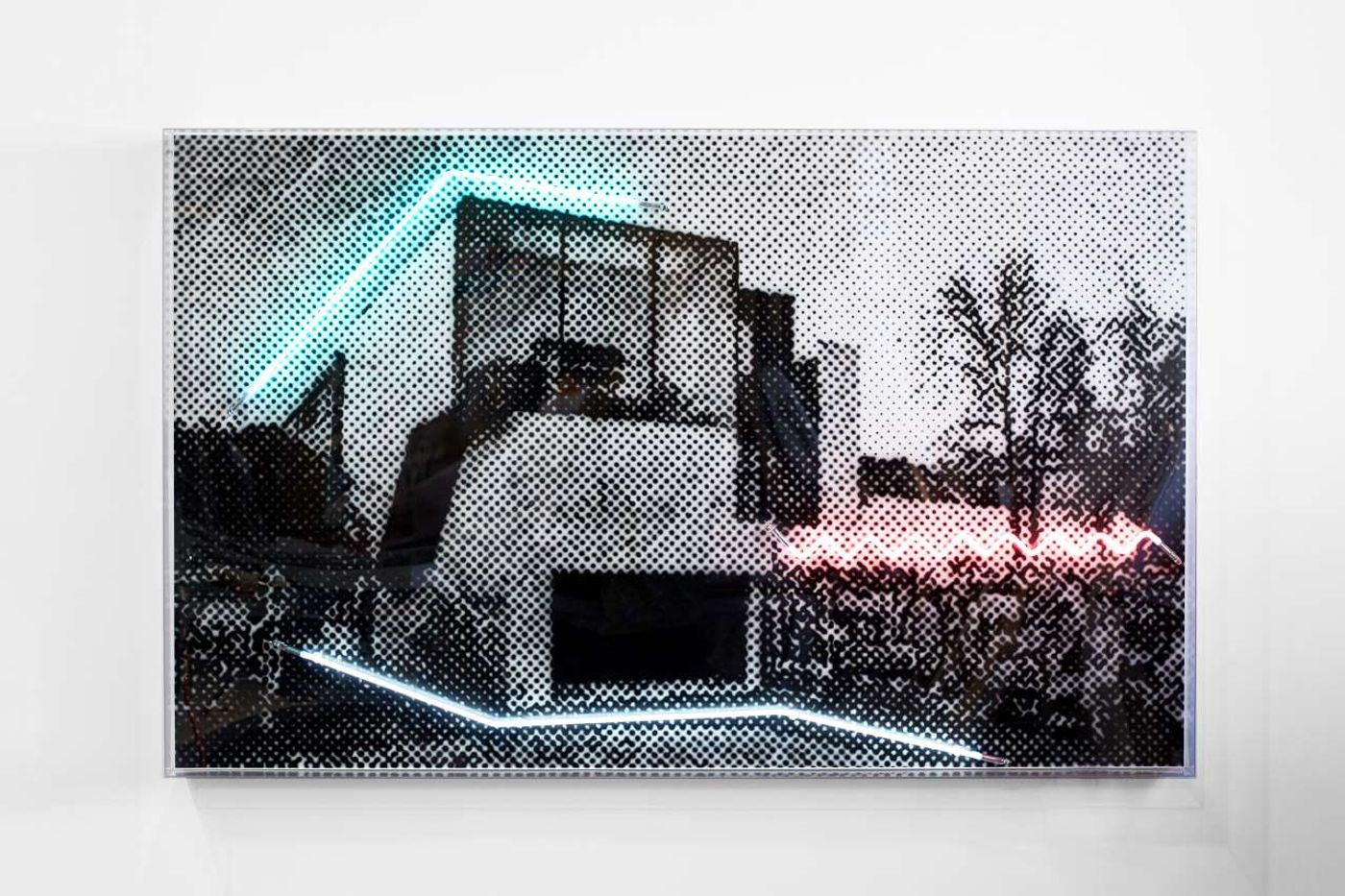
Tom Adair, A house in an unforgiving laneway context, 2018. Airbrush acrylic polymer and neon on dibond, acrylic frame, 125x200cm. © Tom Adair.
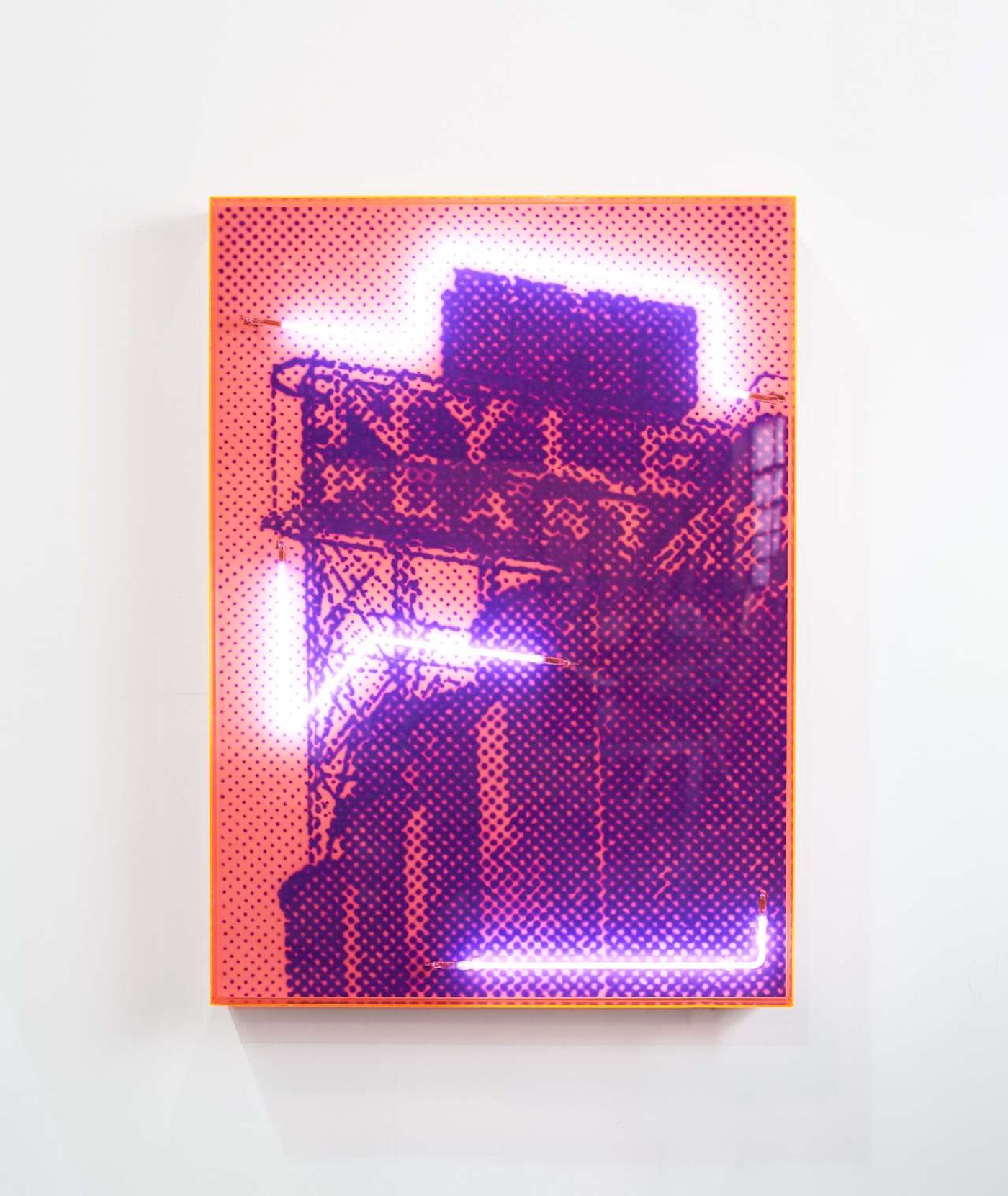
Tom Adair, An industrial past with heritage architecture, Airbrush acrylic polymer and neon on dibond, pink acrylic frame, 90x125cm. © Tom Adair.
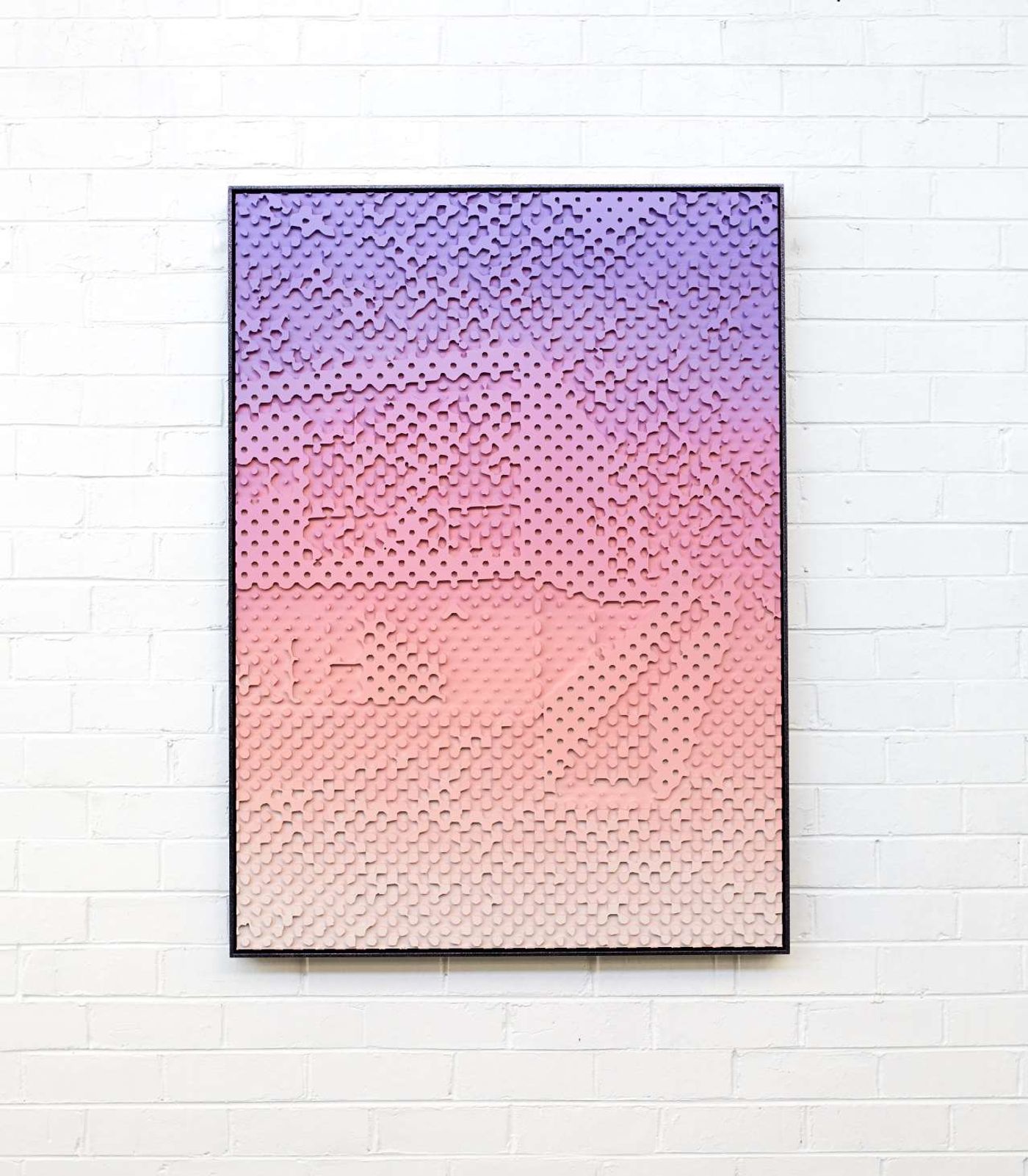
Tom Adair, Untitled CNC, 2019. Acrylic on CNC high density foam board, aluminium powder coat frame, 90x120cm. © Tom Adair.
Your artistic practice was forged through your involvement with street art. How did this phase influence you as an artist?
I was always creative as a kid, drawing, painting and building during every spare moment I had. I grew up in the country, an hour from Melbourne so I wasn’t exposed to graffiti until late into high school when I was old enough to catch the train into the city with friends. I remember seeing all these amazing colourful and stylised words emblazoned on the sides of buildings and this definitely had an early impact on me and kick started my after-dark activities in illegal graffiti. I painted graffiti for about 10 years before being busted and trading in the streets for my first studio space; a real turning point in my life and something I vividly remember.
Graffiti mentality and skills are still with me today in the back of my mind. The ability to paint with immediacy and accuracy has been translated seamlessly into my use with the airbrush. When I think about new work, it almost always involves some kind of spray paint, from a small and intricate airbrush to a large free flowing automotive paint gun.
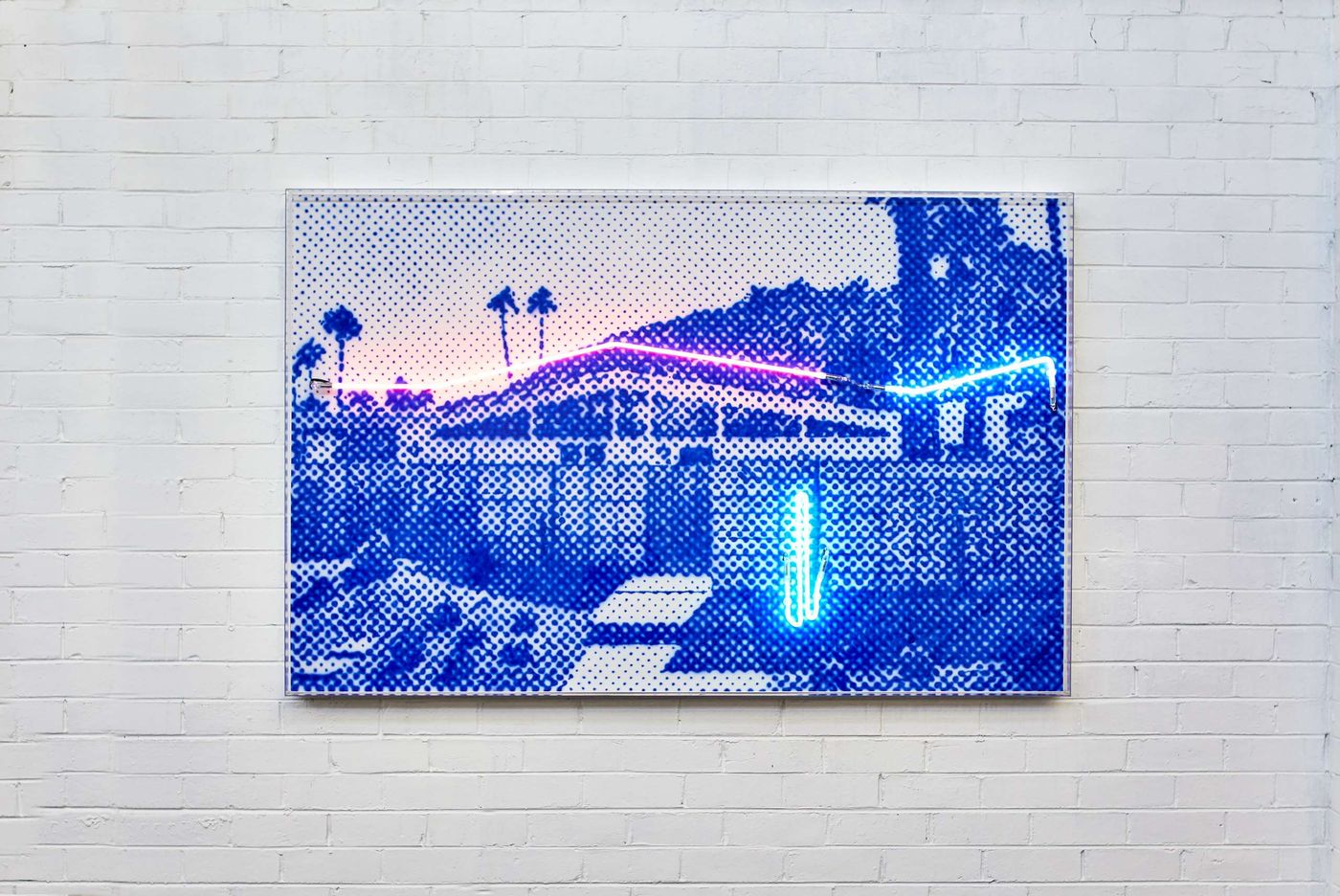
Tom Adair, Desert Los Vista, Airbrush acrylic polymer and neon on dibond, acrylic frame, 120x180cm. © Tom Adair.

Tom Adair, Desert Los Vista, Airbrush acrylic polymer and neon on dibond, acrylic frame, 120x180cm. © Tom Adair.
You have a very idiosyncratic, multi-disciplinary creative process that marries analogue and digital techniques and involves a wide range of mediums. How did you come up with such a process and how has it evolved?
For the first 5-6 years in the studio I was trying to work out my own style, something that wasn’t a stencil or graffiti on a canvas - I felt they had both been done to death. During this period I was exposed to photography and graphic design, learning how to take photos and manipulate them on the computer into different forms with varying effects.
In high school I saw a documentary about my favourite painter, Howard Arkley, an airbrush artist from Melbourne. My school had airbrushes, I remember how fiddly they were to use so I quickly gave up on them until 2015 when I decided to enrol myself in an airbrush course and learn how to use the tool again. This time I mastered it! Later, I wanted to add another element. I had some spare neon sections lying around so I screwed them to a finished piece and from there I knew the combination of techniques and mediums was something I could call my own.
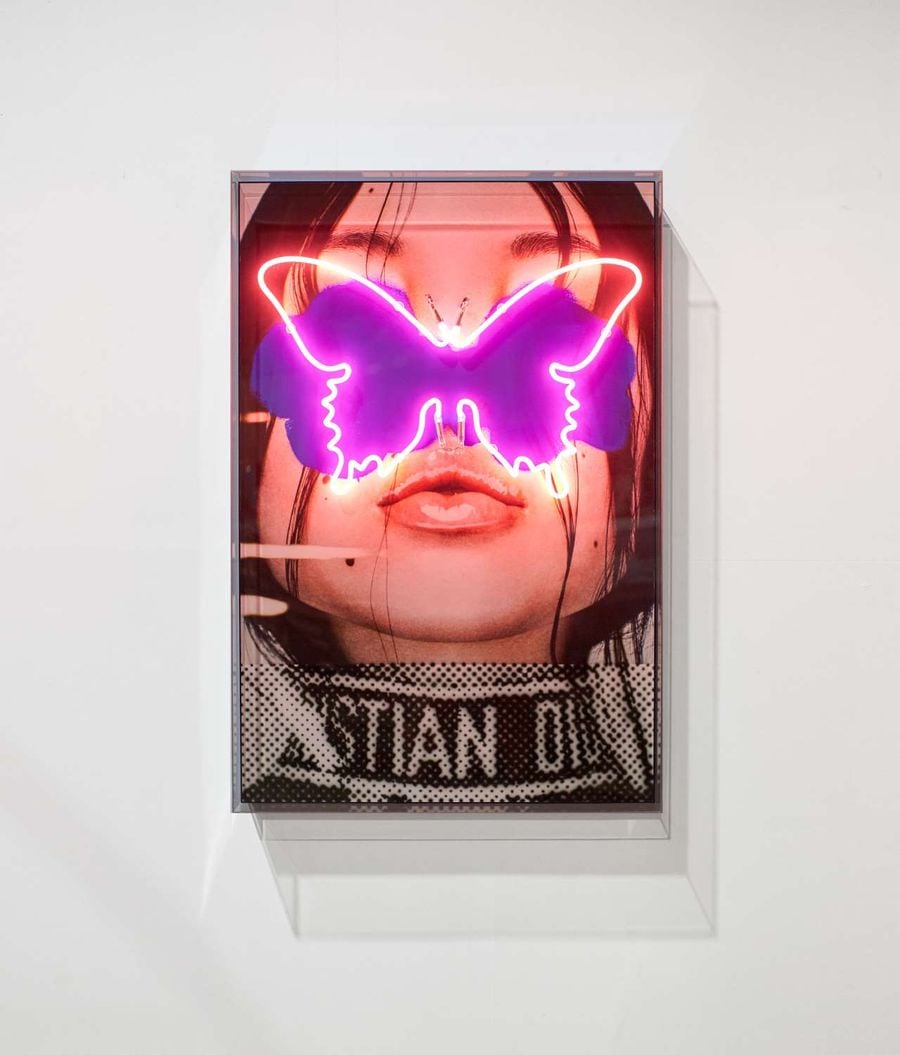
Dina Broadhurst x Tom Adair, Flutterby, Exclusive limited edition of 10 pieces, 80 x 120 x 16 cm. Giclee print on smooth cotton rag paper, mounted on dibond, airbrush acrylic, hand bent glass neon in pink, clear acrylic box frame with blue mirror acrylic edging, requires 240v. © Tom Adair.

Tom Adair, Gwynne Street, 2017. Airbrush acrylic polymer and neon on dibond, acrylic frame, 110x170cm. © Tom Adair.
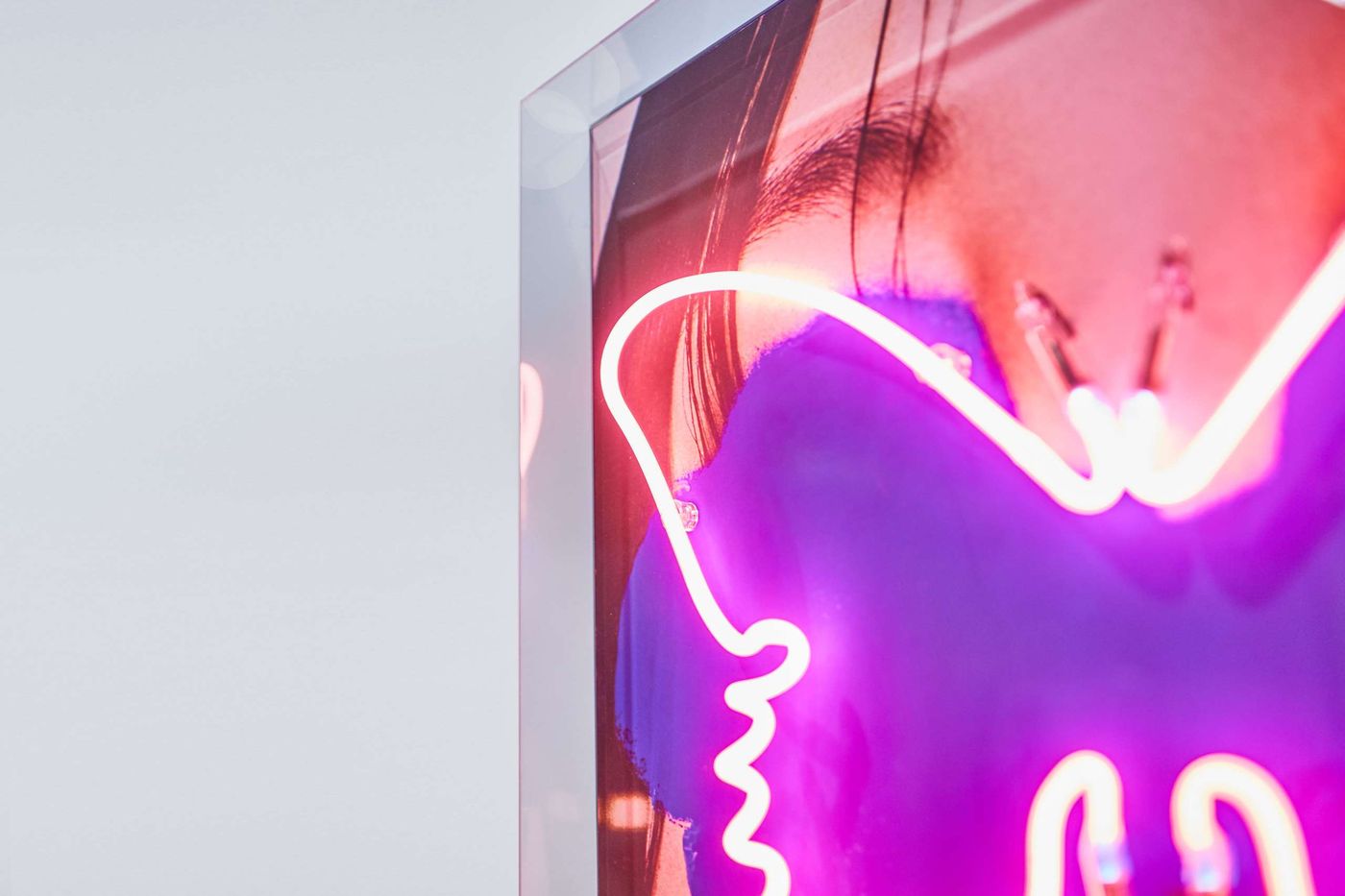
Dina Broadhurst x Tom Adair, Flutterby (detail). Photo © Tom Adair.
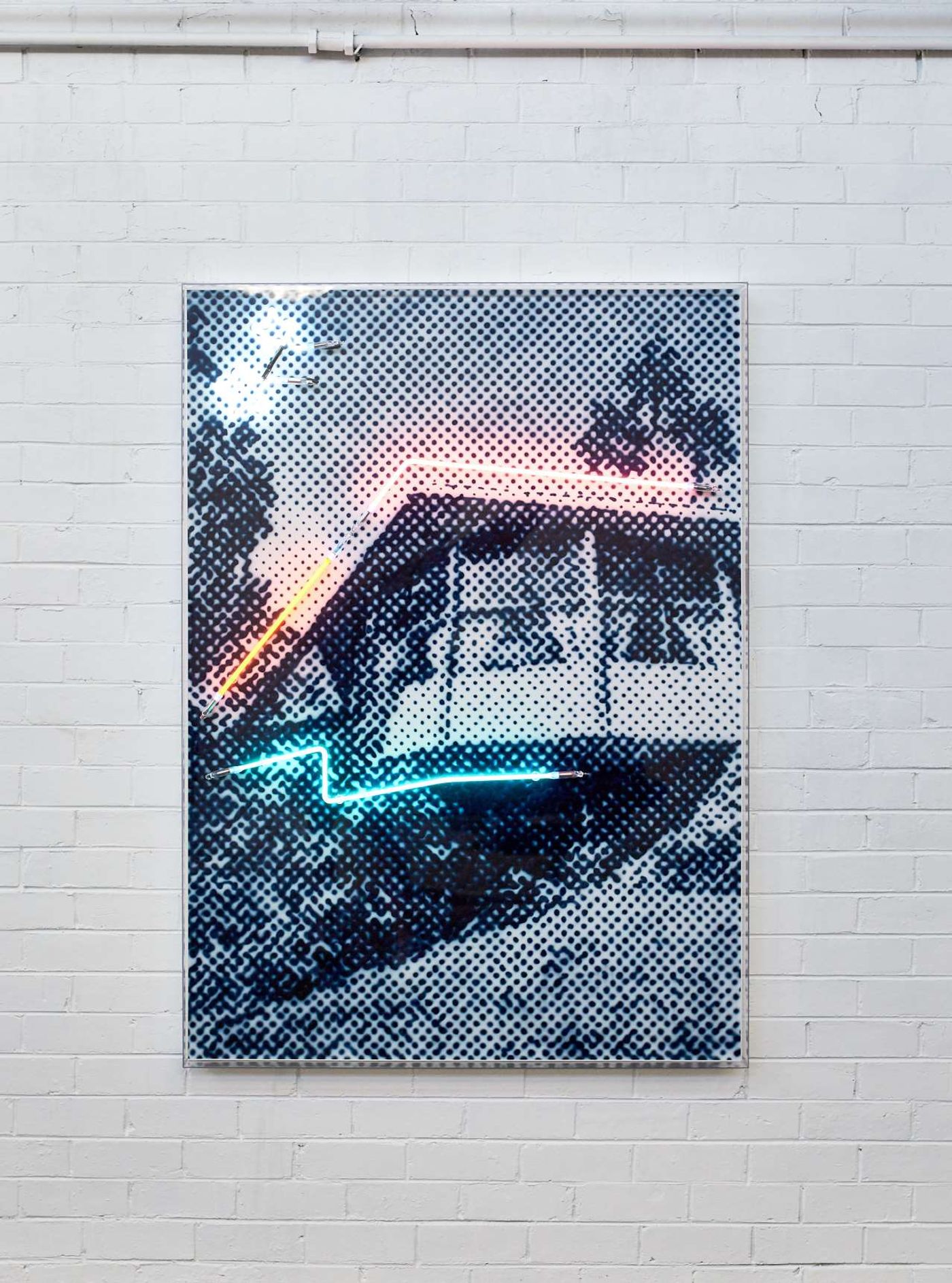
Tom Adair, House of tomorrow, Airbrush acrylic polymer and neon on dibond, acrylic frame, 115x160cm. © Tom Adair.

Tom Adair, House of tomorrow, Airbrush acrylic polymer and neon on dibond, acrylic frame, 115x160cm. © Tom Adair.
There is something quite ironic in your use of monochrome halftone which you painstakingly simulate by hand. Where does your affinity for halftone stem from? What is the purpose of turning the printing technique on its head, from a means of reproduction to one-of-a-kind hand-painted pieces?
I have always loved halftone and was first introduced to its application through a fashion brand I started (Restinpeace) when we were screen printing t-shirts. It wasn’t until I took the airbrush course that I realised that I could enlarge the halftone to a scale that would allow me to paint it by hand using an airbrush.
In my artwork I play with viewing distance and perception. I paint houses which seem perfect from afar, like the lives of those living there. However, when you get closer to the artwork you find imperfections, just as you find personal or family issues and financial pressures when you focus on the people behind the picture-perfect facades. The imperfections of the painting can only be achieved by hand; a printed image doesn’t have the same character. It’s the drips, the overspray and movement that I really love when a piece is finished. Unfortunately in the digital age, this isn’t translated or communicated through digital mediums, you can’t pick-up the minute detail and character of my work through a screen.
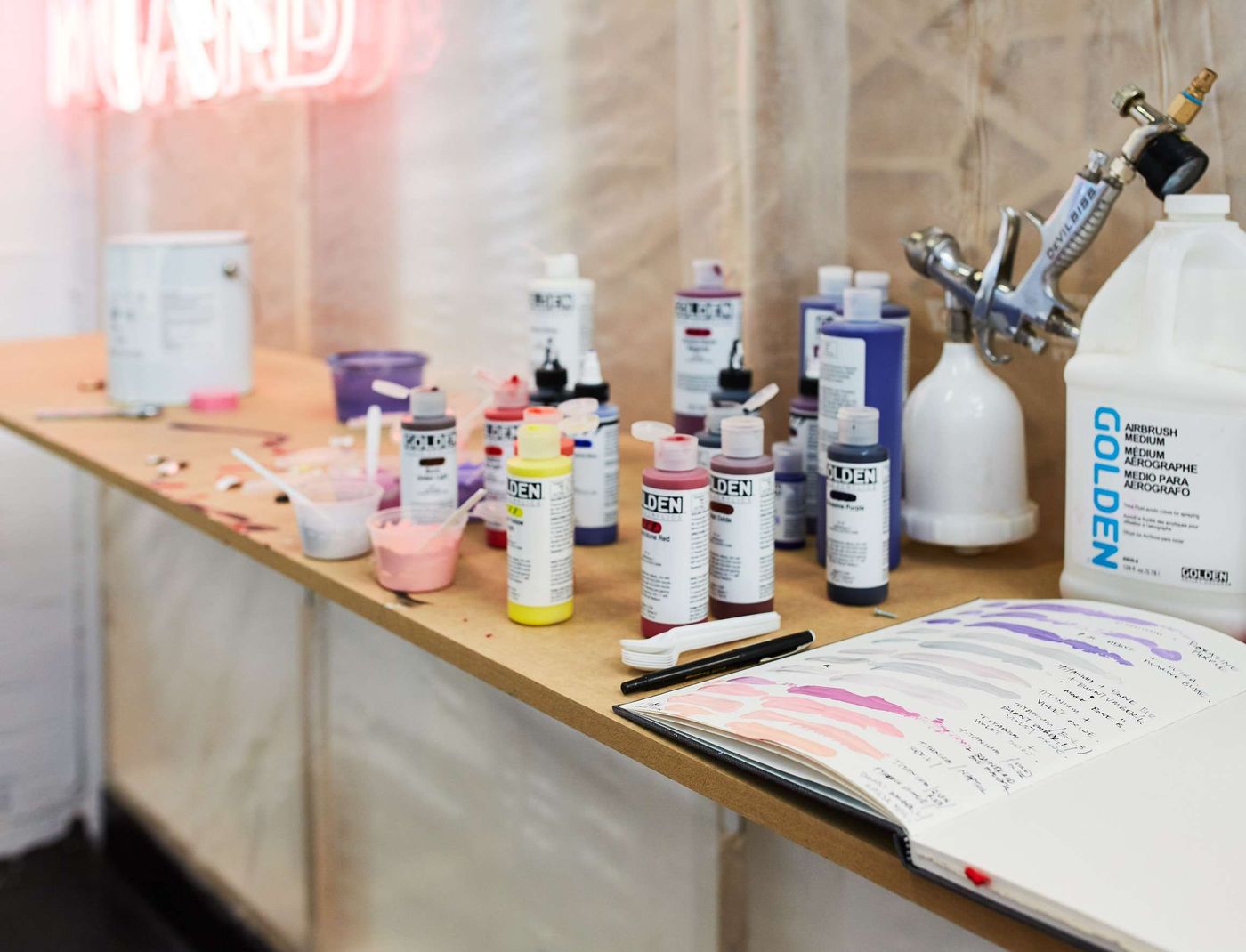
Photo © Tom Adair.
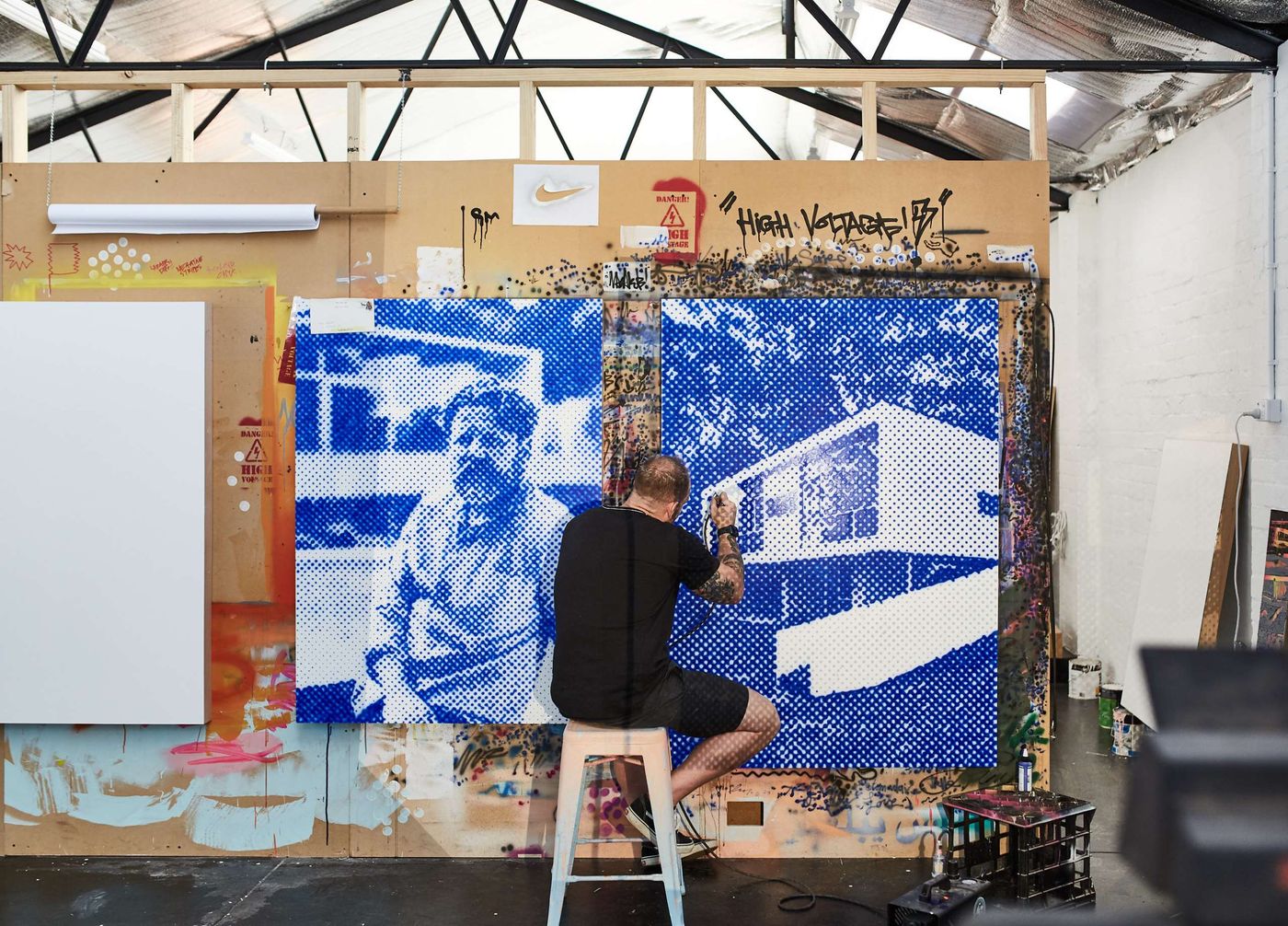
Photo © Tom Adair.
Your work is a product of a painstaking process of air-brushing and hand-shaping neon. How laborious and time consuming is the creation of each piece? Apart from the finished work, is there an emotional reward you get out of such an arduous process?
A single piece will take around one week to paint and create the neon, plus framing which is also done in-house in the studio. Although this may seem quick to some people, the full time from start to finish including photography and framing is usually around 6-8 weeks.
I have a great deal of personal satisfaction every time I switch on a finished artwork. The pieces are always slightly different than the digital version so it’s always a nice surprise to see how the final piece works in real life. Painting the work by hand is time consuming but I find it fulfilling, it’s time that I get to spend with myself - meditation in a way. Once I'm in the groove I can zone out and just paint, it’s really peaceful.
Suburban residences are a recurring theme in your recent work. What prompted you to depict such residential settings and what do you want to convey? What is your relationship with architecture?
I worked for a large furniture company in Australia, which exposed me to the work of some of Australia’s best interior designers and architects. I’ve always loved architecture, and this period of my life definitely had an influence on my work as an artist.
The architecture I depict is a motif for the relationship between what you see from the outside versus reality. We’re so quick to perceive people in a certain way because of the house they own or the car they drive. When we (the viewer) get a little bit closer, the perception (or image) deteriorates and its imperfections are exposed. That’s why my work changes depending on where you view it from.
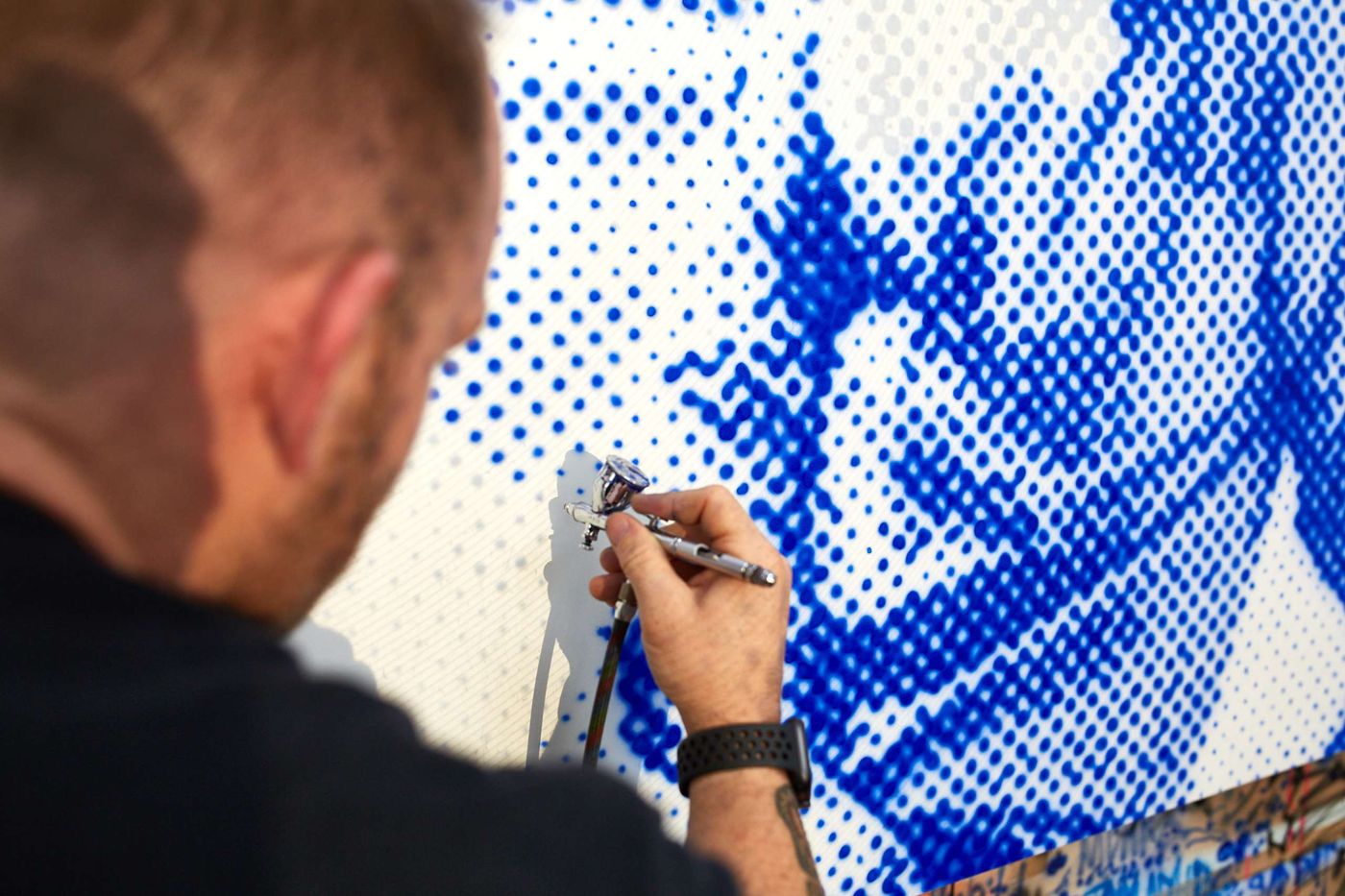
Photo © Tom Adair.
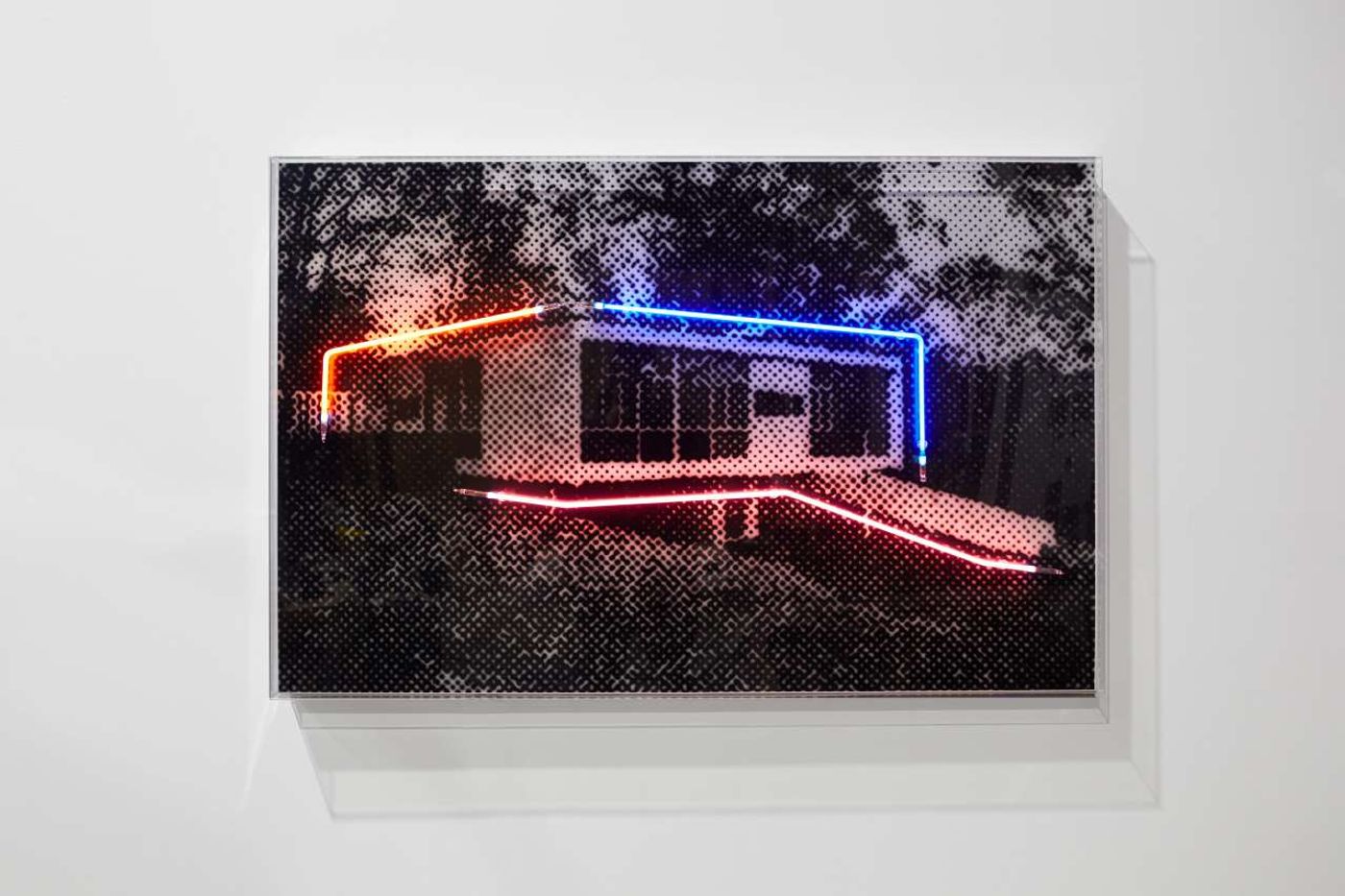
Tom Adair, Whisper quiet in a bushland setting, Airbrush acrylic polymer and neon on dibond, acrylic frame, 110x170cm. © Tom Adair.
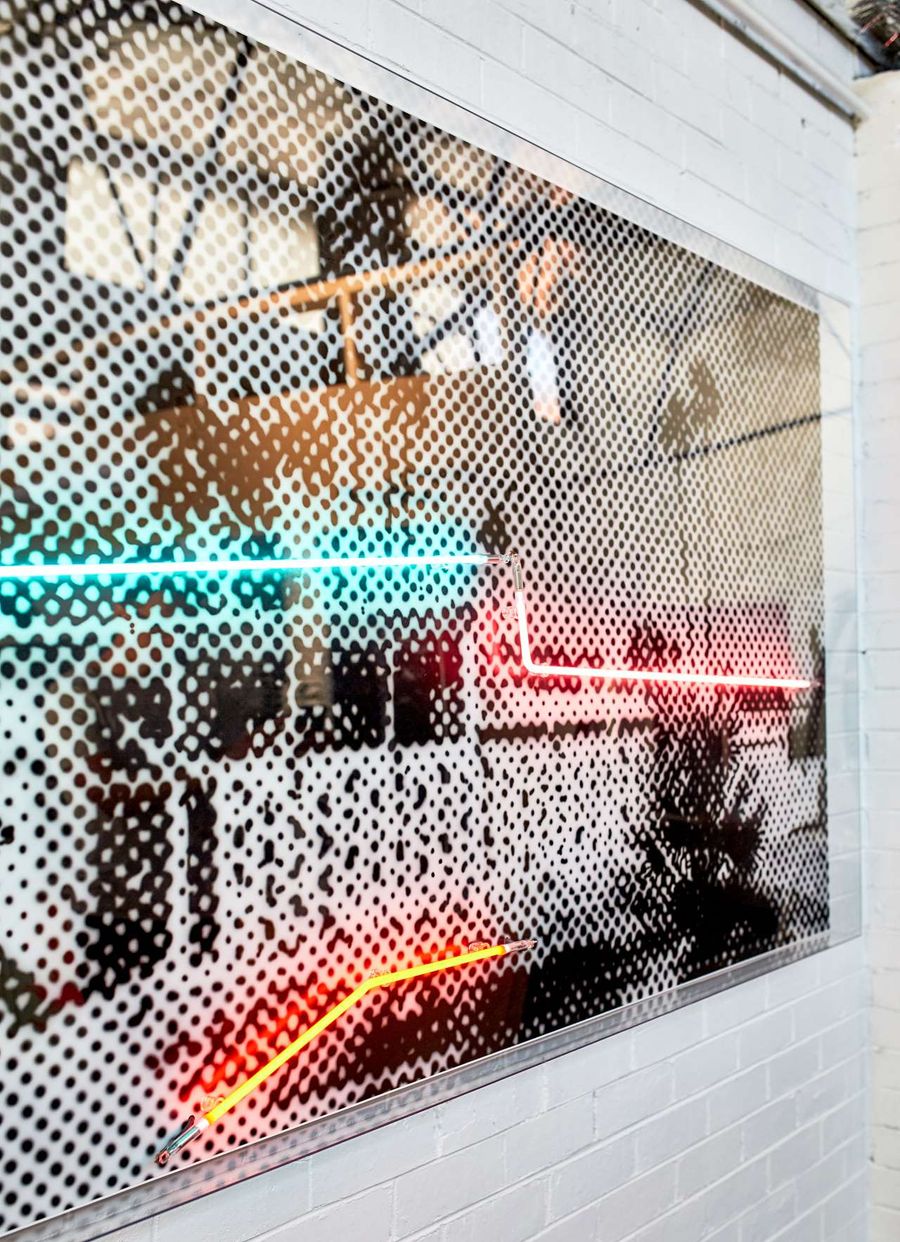
Tom Adair, Twin Palms, 2019. Airbrush polymer and neon on Dibond, Acrylic frame,120x200cm. © Tom Adair.
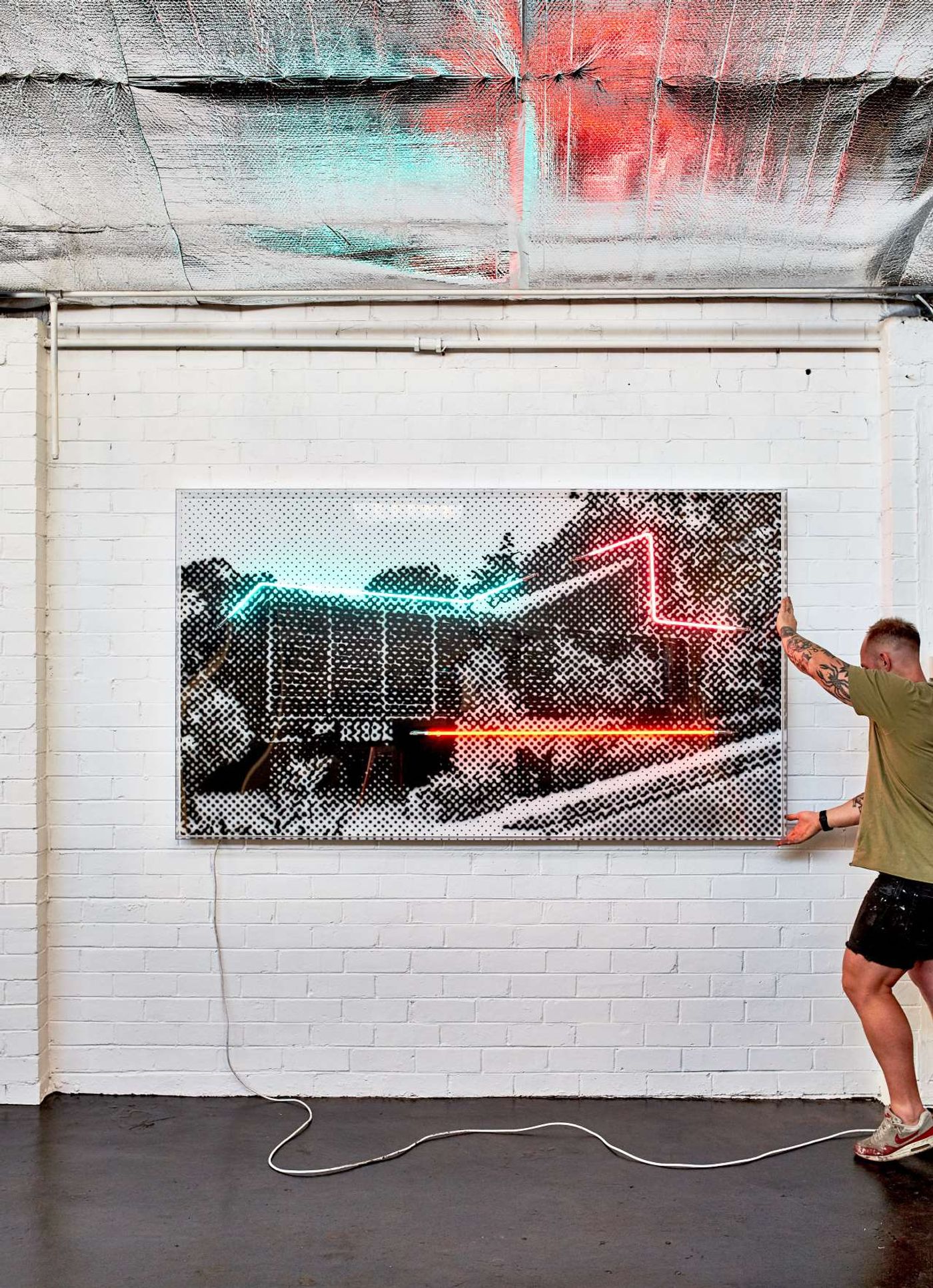
Tom Adair, Yarra St House, 2019. Airbrush polymer and neon on Dibond, Acrylic frame, 120x200cm. © Tom Adair.
What made you introduce neon into your work? Is there a connection between your street art background and neon’s widespread use in street signs? What is the effect you are trying to achieve?
At the same time I was developing my style in the studio I had begun to work with neon signs as a medium for my artwork. The first piece I made was a bright pink cursive ‘fuck’ sign. I made standalone neon artworks for about seven or eight years. The marriage of the two mediums was accidental, not something I planned. Neon to me is less about signage, I consider it more as a drawing tool. The neon sections I overlay on my work are highlights, important details or forms of the painted artwork that lies beneath it.
Lately you have created textural artworks out of HDP foam that appear as 3-dimensional halftone images. Why did you choose this material? How do you achieve this intriguing effect?
My new CNC HDP foam pieces are a move further in the direction of abstracted perception. The work is more sculptural and textural up close and is meant to be less about the image and more about the abstraction.
It took some time to develop these to a point that I was happy. I tested a few different materials, MDF, Plywood, plastics but nothing worked as well as high density polyurethane foam. HDP foam is a unique material and quite common in the automotive prototyping industry. I have adapted it in a way that allows me to exploit modern technology and use a CNC router to cut my halftone images in a sculptural form. Once the foam has been cut and shaped I paint it by hand using automotive paint guns in my studio.
Framing is an integral part of your artwork. Do you make all your frames yourself? How do the frames inform the work?
I don’t physically make the frames myself, but I do design them and work with different manufacturers who produce them specifically for me. My career as a product developer for a furniture company influenced my ability to source new and unusual materials that aren’t available through regular framers. All the framing is done in-house in my studio so I can control exactly how it’s finished.
For me the frame is part of the artwork and it needs to be complementary to it so they become one. The acrylic frames for my neon works were designed so that I can expose the electrodes and show the electrified gas without covering up this detail, something that is considered ‘ugly’ in the neon industry, but my framing allows me to celebrate it.
Although you work in a studio there is strong element of street art in your practice. Do you still consider yourself a street artist in some respects?
I’ve tried to move away from branding myself as a street artist, moving towards a fine art or contemporary art direction. The skills and techniques I learnt early on in my graffiti era still have influence my work but my street art days are well finished. I still love seeing graffiti when I’m driving around and appreciate the art form, it’s just not something that I identify with any more.
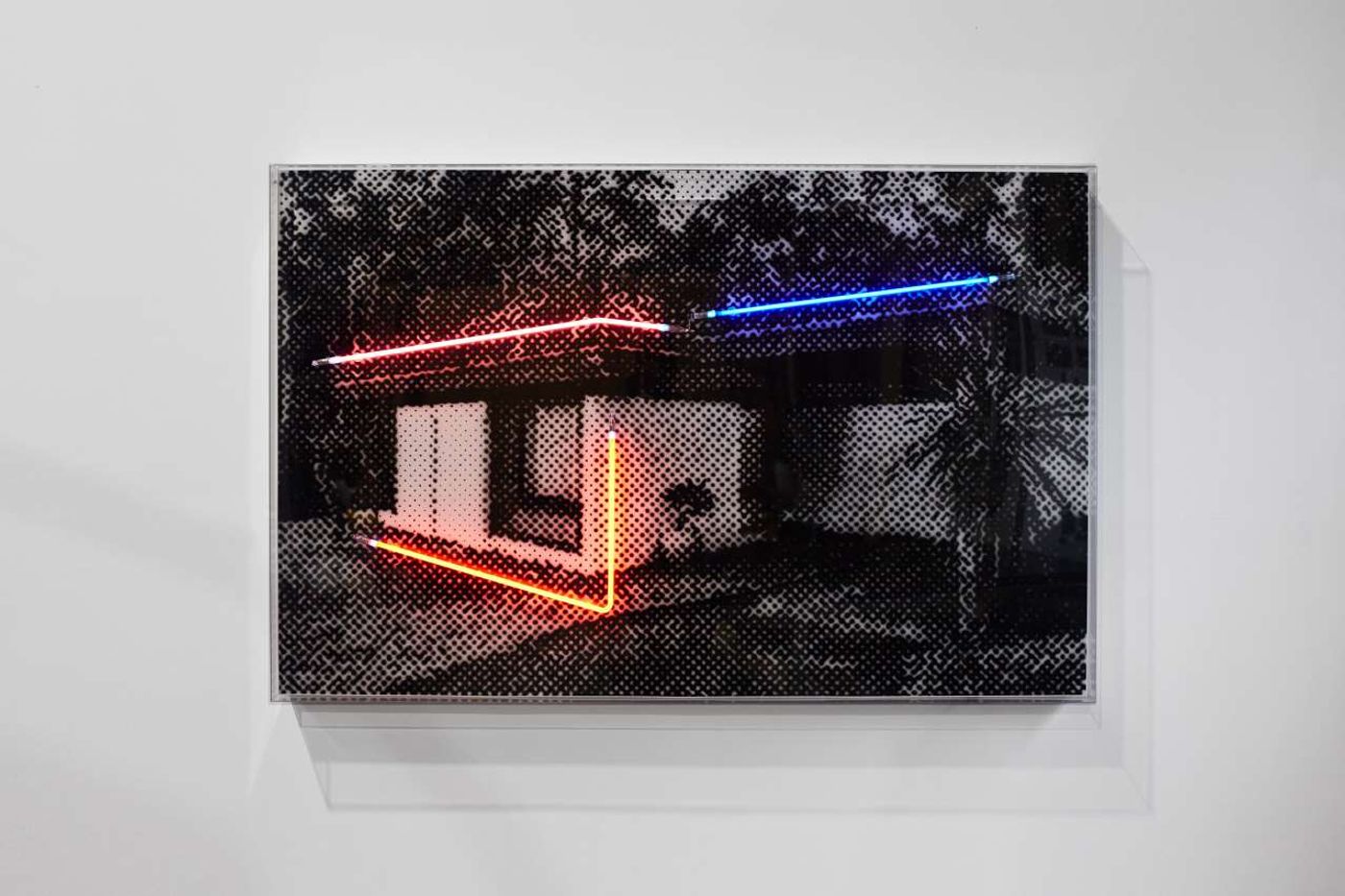
Tom Adair, A quiet cul-de-sac, Airbrush acrylic polymer and neon on dibond, acrylic frame, 110x170cm. © Tom Adair.

Tom Adair, Twin Palms, 2019. Airbrush polymer and neon on Dibond, Acrylic frame,120x200cm. © Tom Adair.
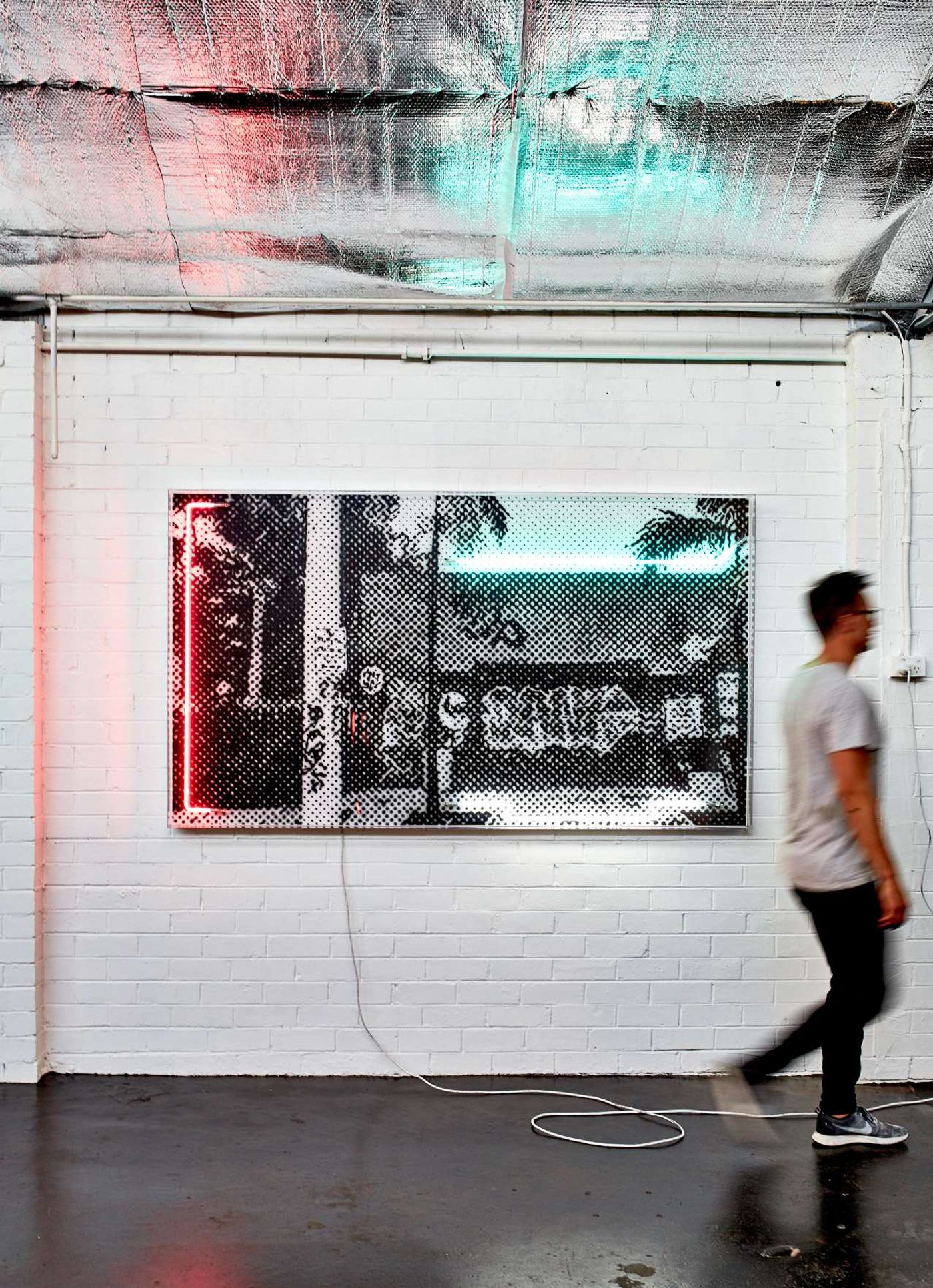
Tom Adair, Wynwood Walls, 2019. Airbrush polymer and neon on Dibond, Acrylic frame, 120x200cm. © Tom Adair.
What are you working on right now? Any plans for future exhibitions?
I’ve just sent my first six works over to a gallery in Los Angeles to be exhibited in L.A. and New York. That’s been really exciting for me, I really want to do more work in the USA and Europe.
The next project that I've just started is for a luxury hotel in Canberra, Australia. I have been commissioned by Iconic Hotels to produce eight 1.2 by 2.1 metres paintings for the eight lift lobbies in their new ‘Midnight’ hotel launching in September 2019. The brief was to document the local area of Braddon and depict it in the artworks, so I spent a week up in Canberra taking photos and getting to know the locals.
My next planned exhibition is in April/May 2020 at Nanda\Hobbs gallery in Sydney, Australia. Until then I have a bunch of private commissions to complete before I can start any new research and development for a new body of work.
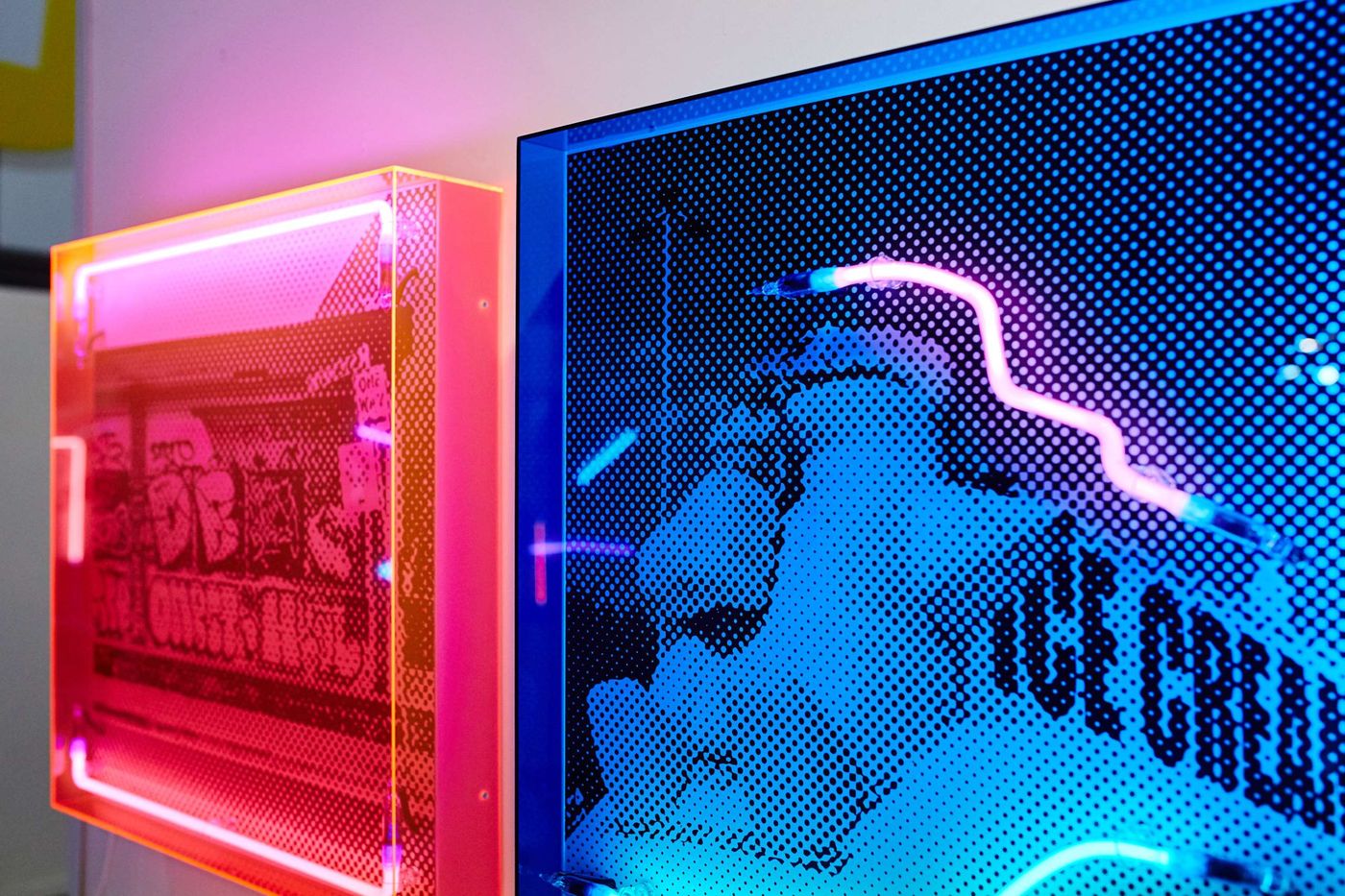
Photo © Tom Adair.
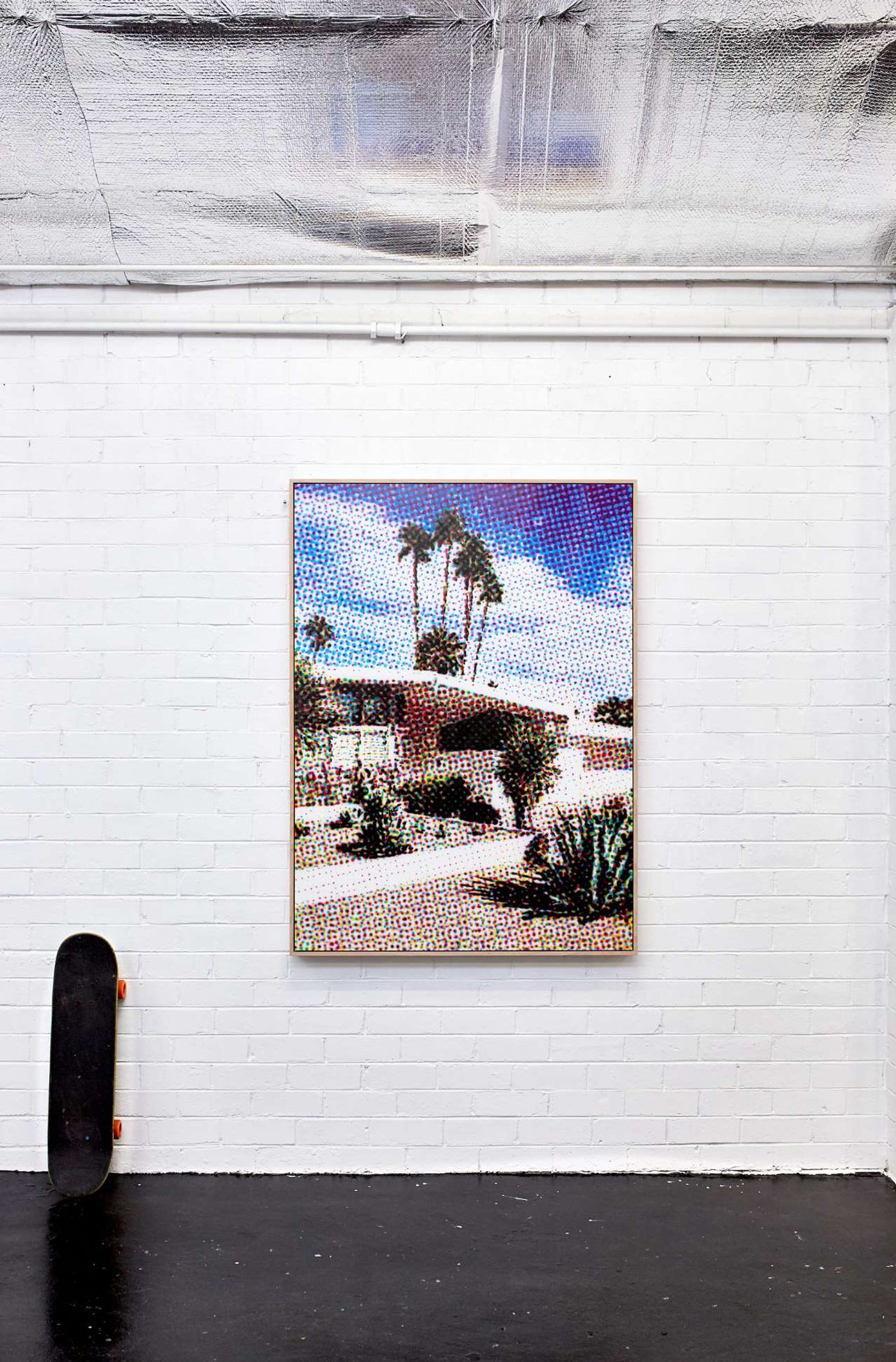
Tom Adair, Desert Vista, 2019. Airbrush on dibond, Oak frame, 105x145cm. © Tom Adair.
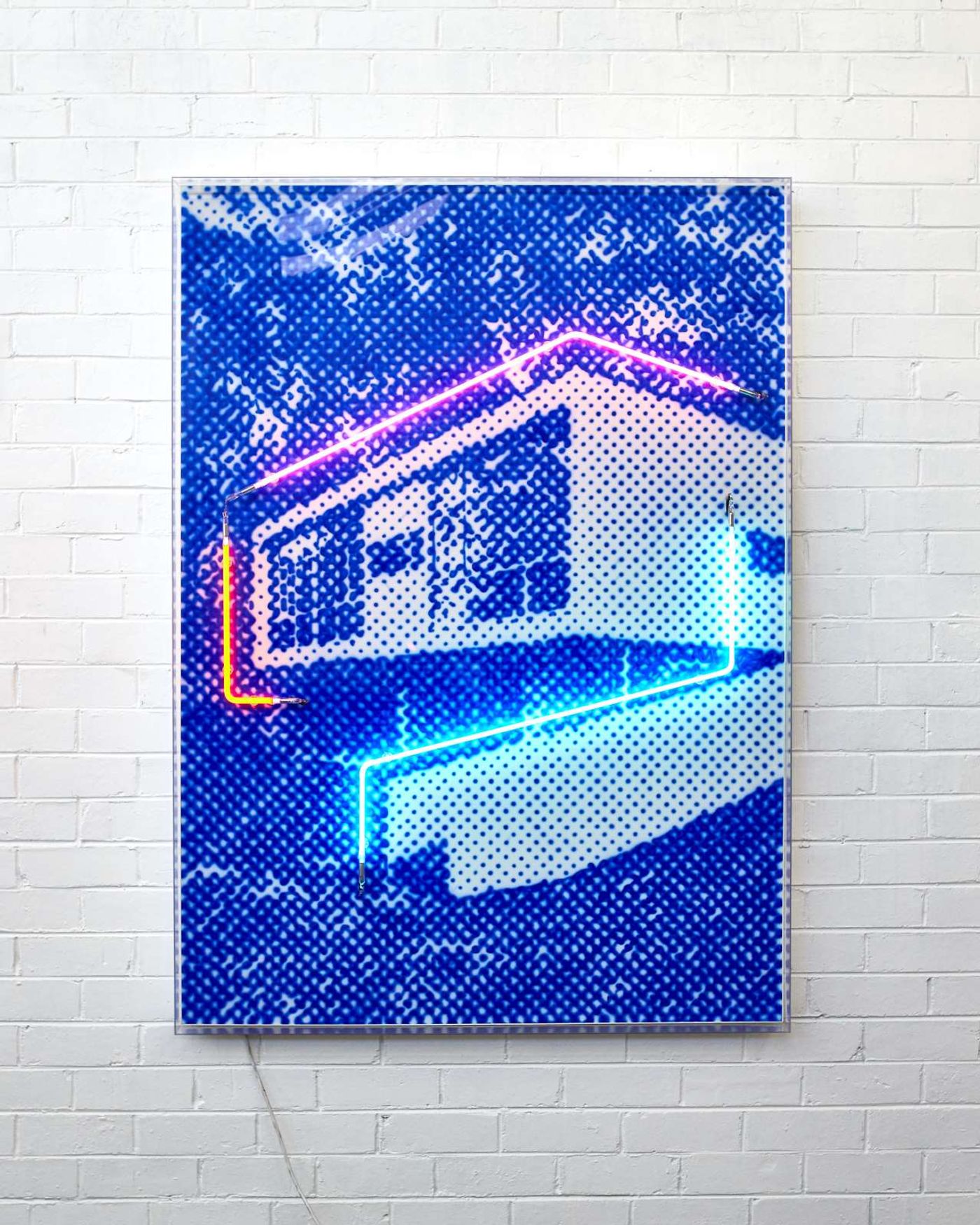
Tom Adair, Bushland Rose, 2019. Airbrush polymer and neon on Dibond, Acrylic frame, 105x160cm. © Tom Adair.

Tom Adair, House of tomorrow, Airbrush acrylic polymer and neon on dibond, acrylic frame, 115x160cm. © Tom Adair.
